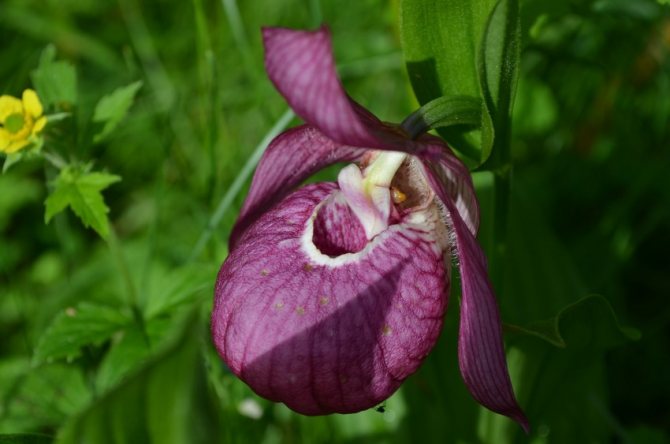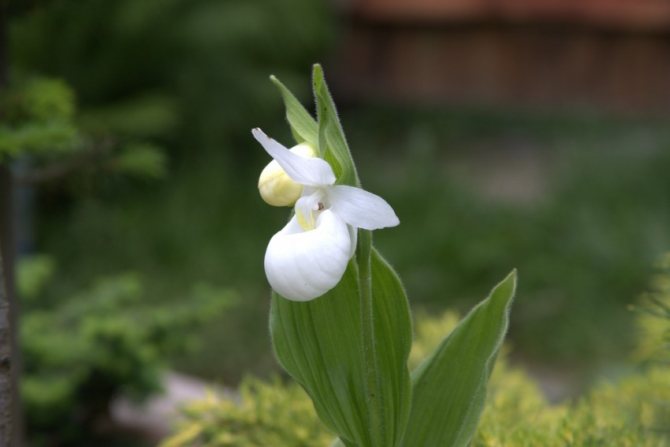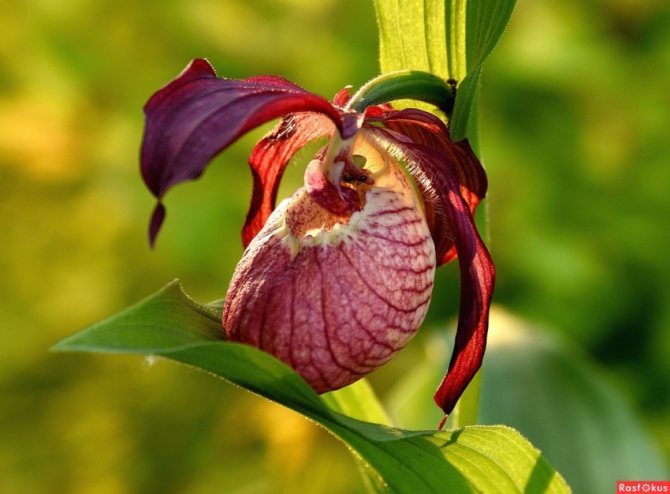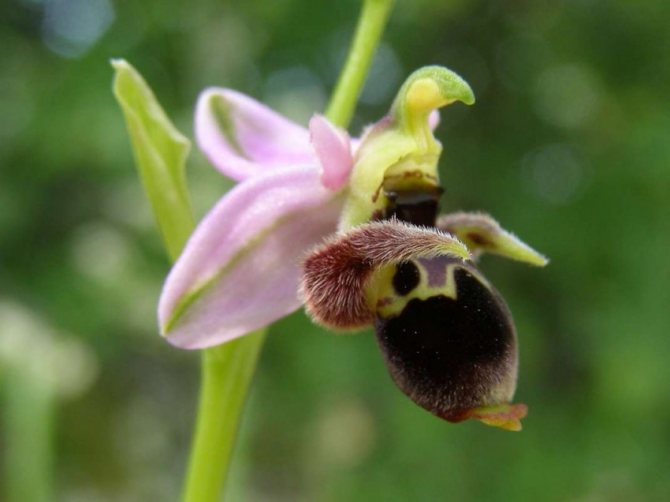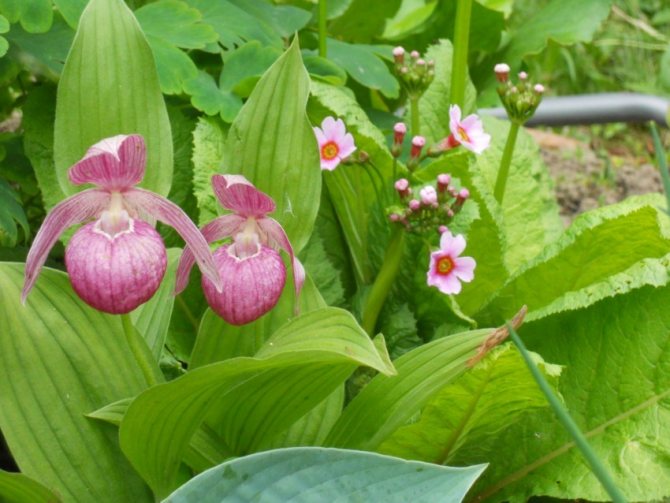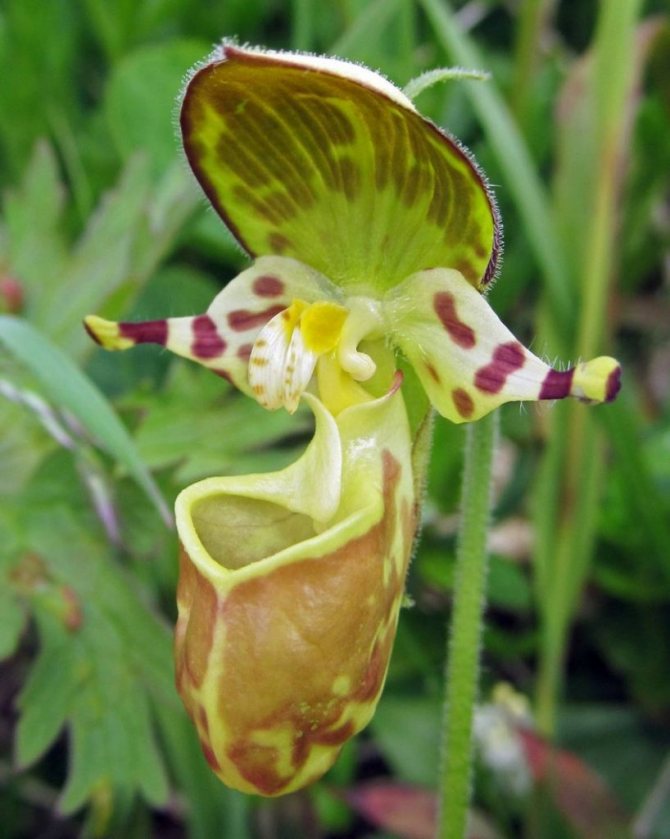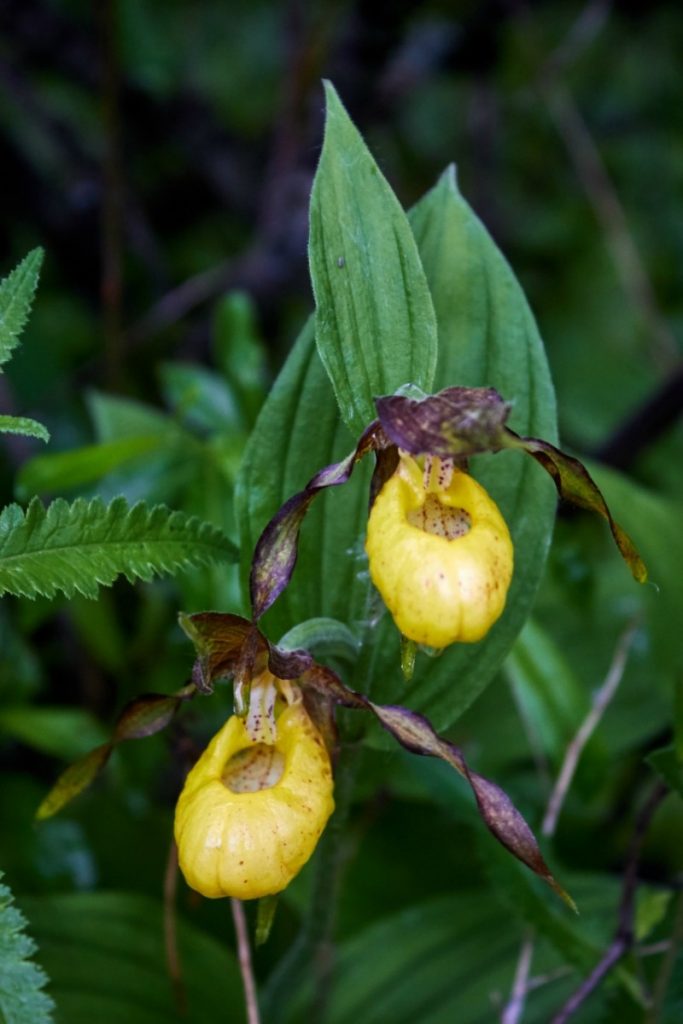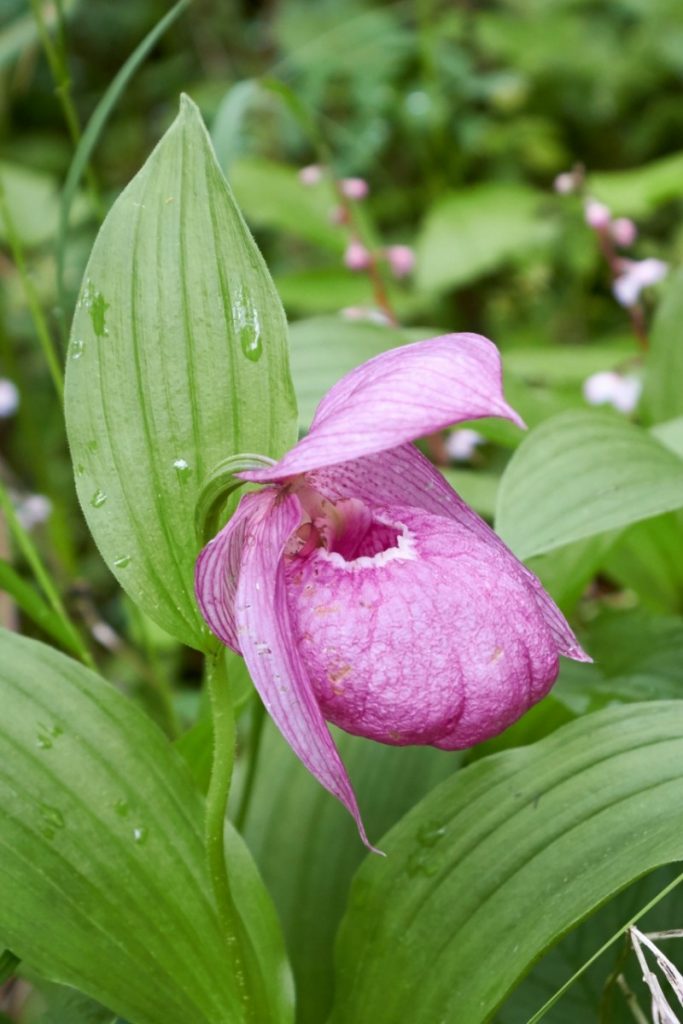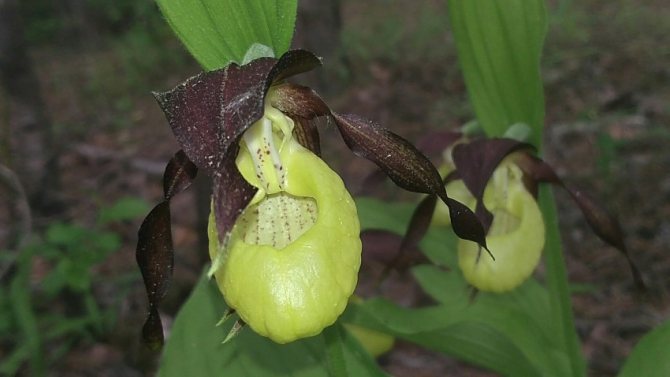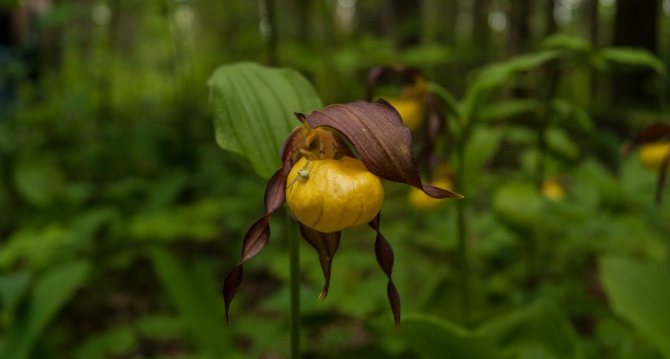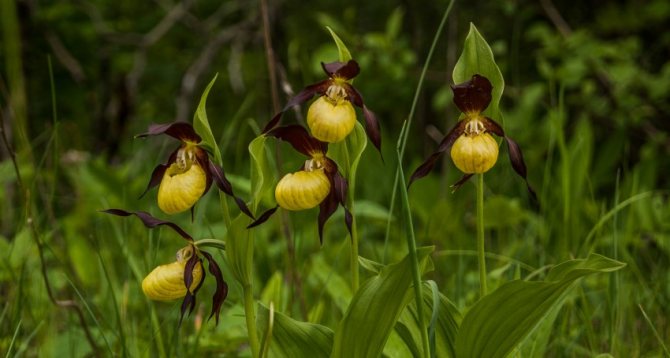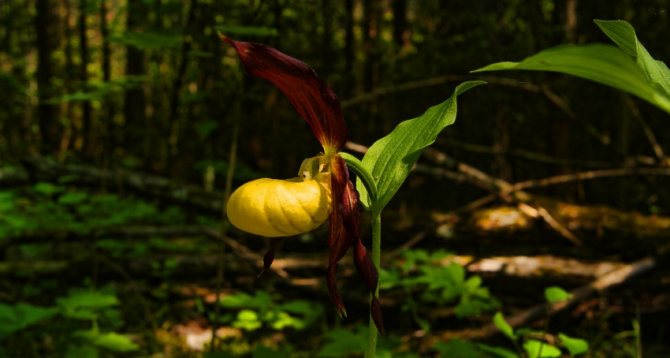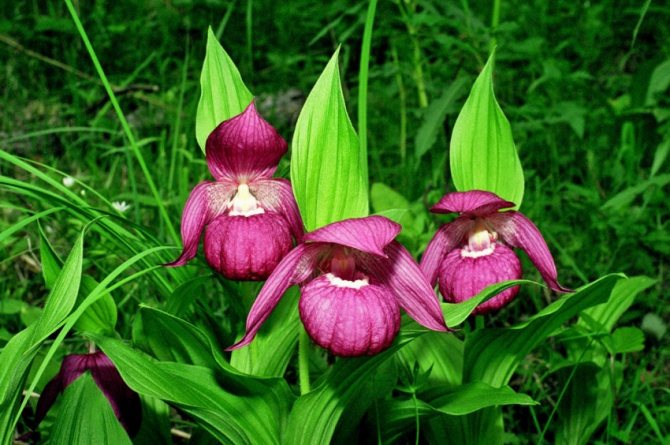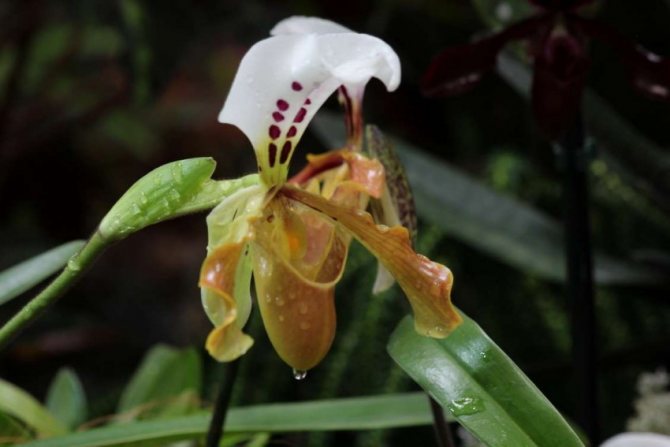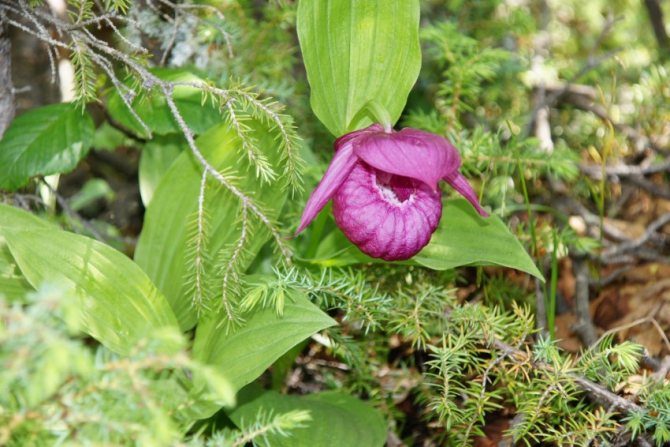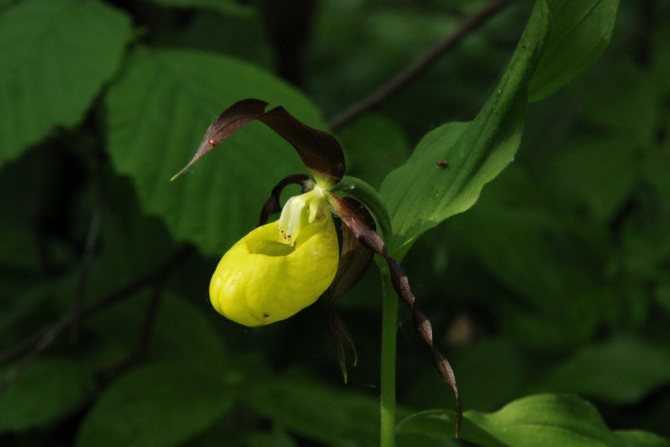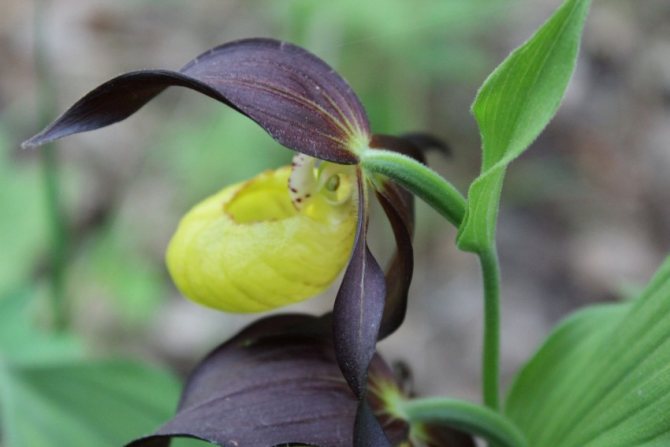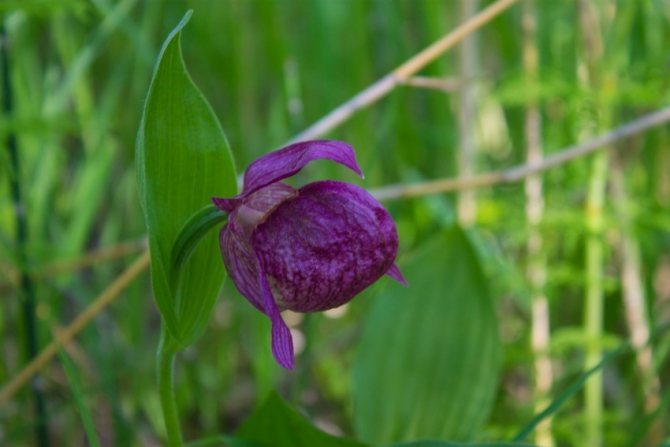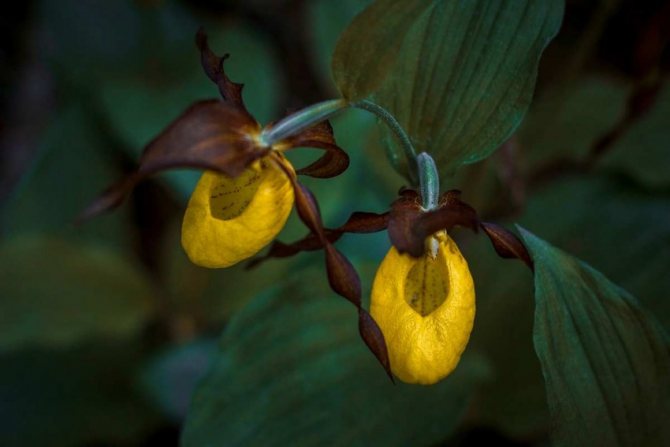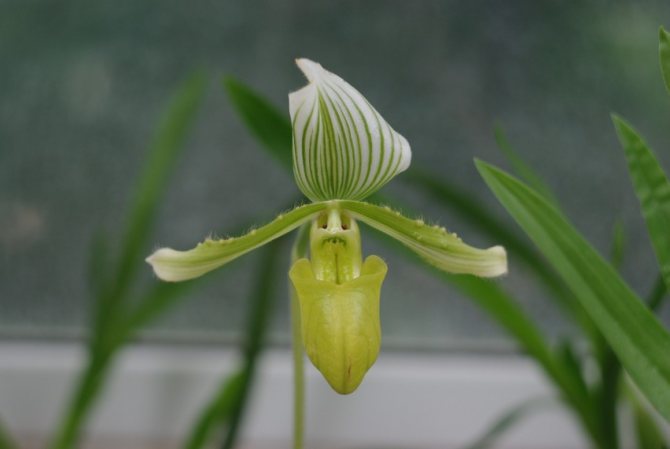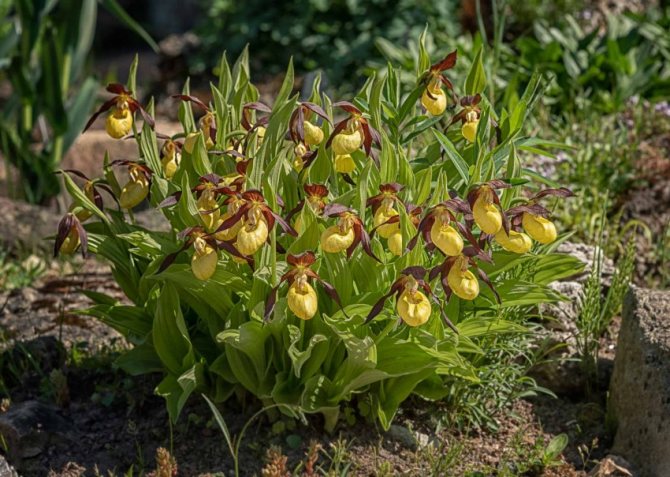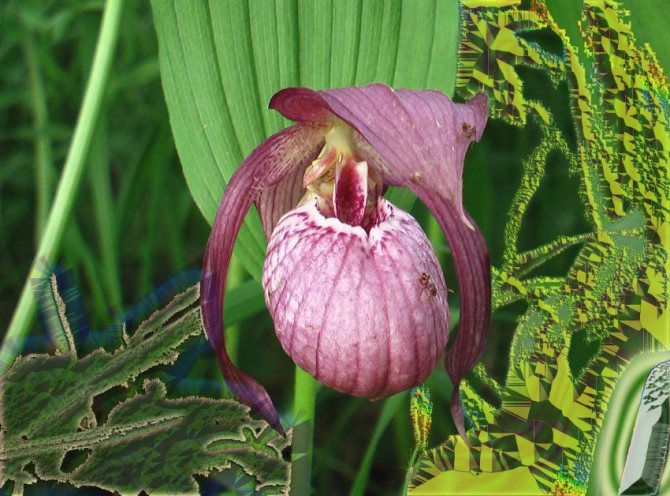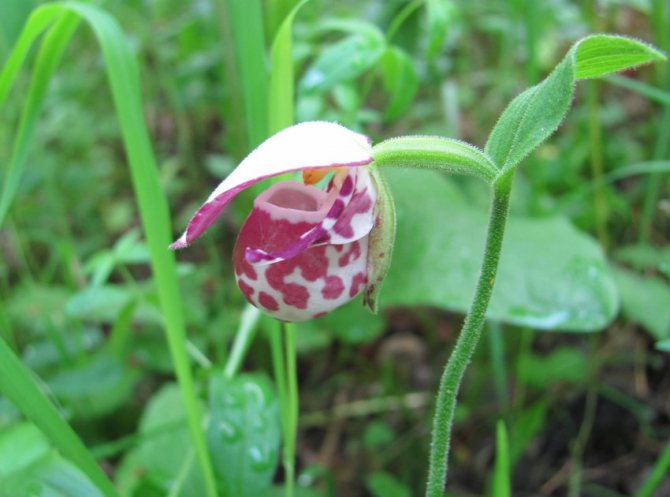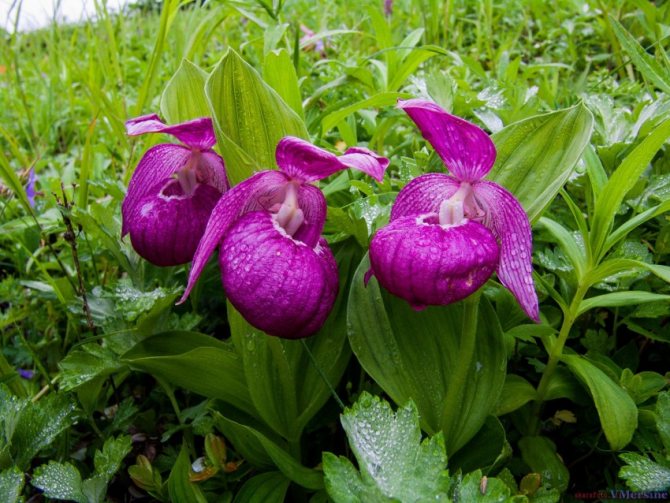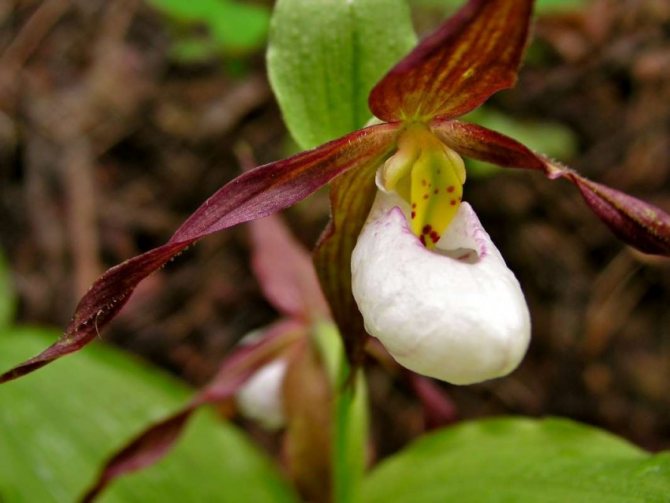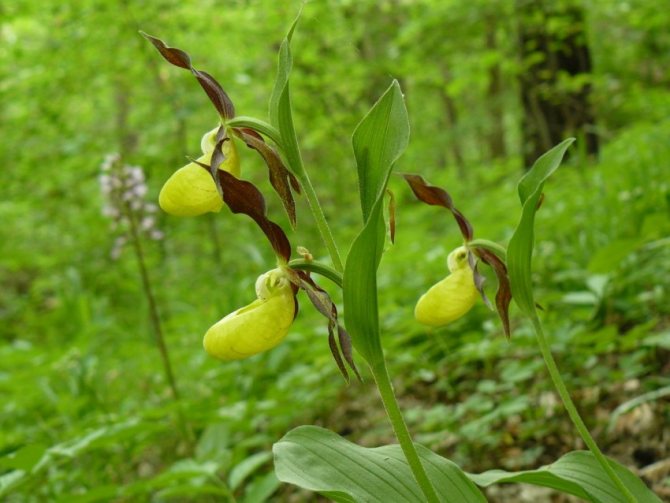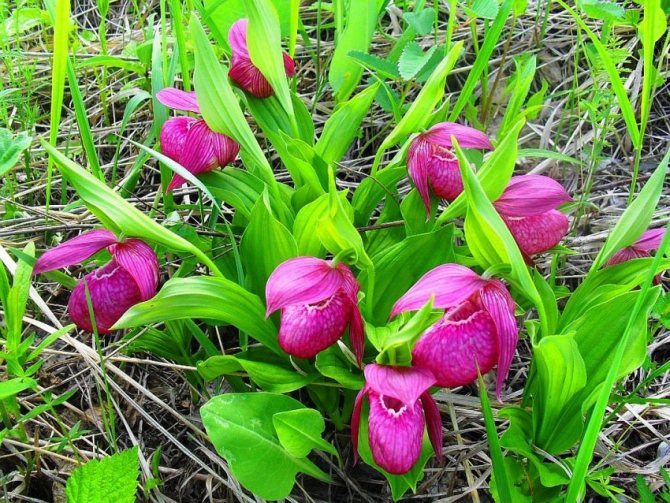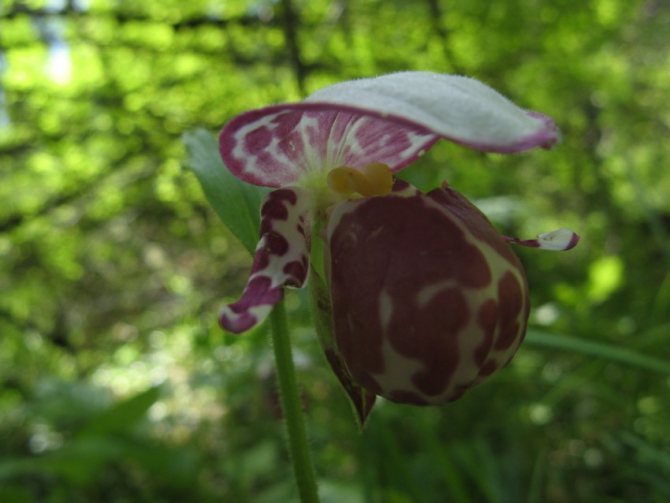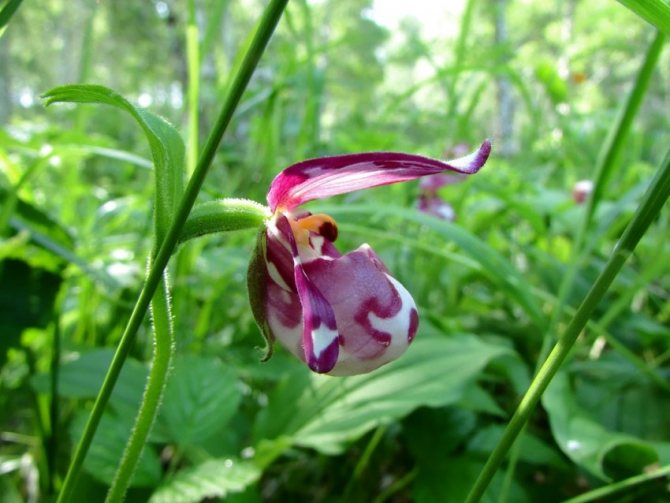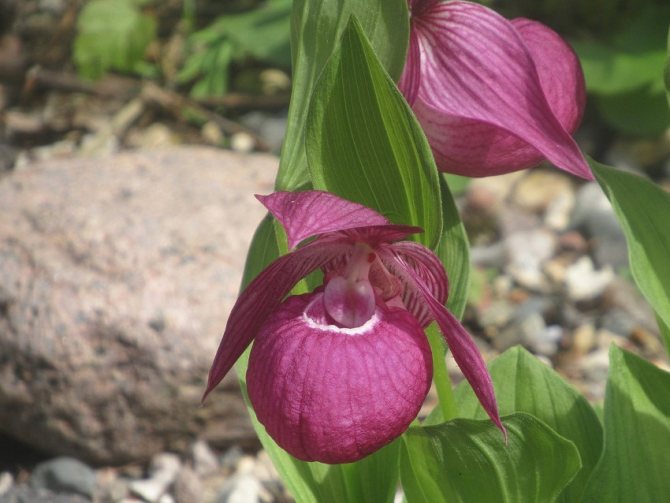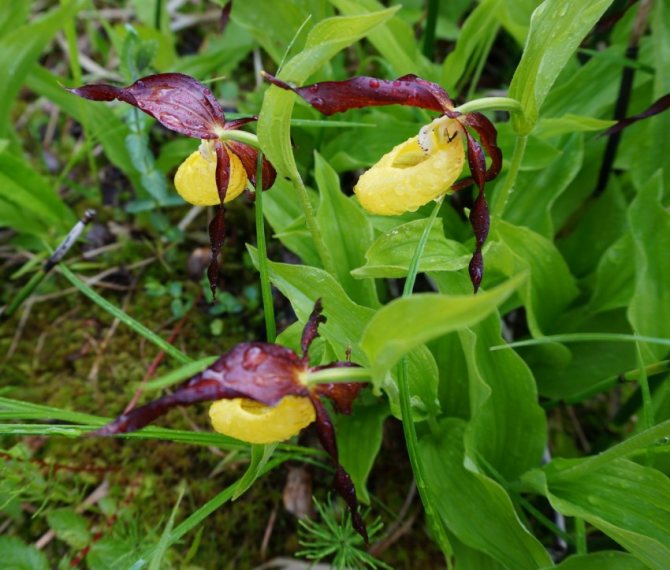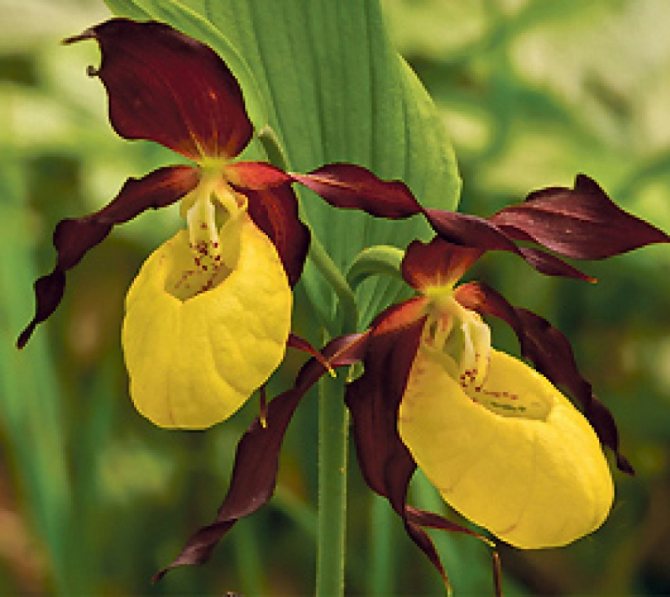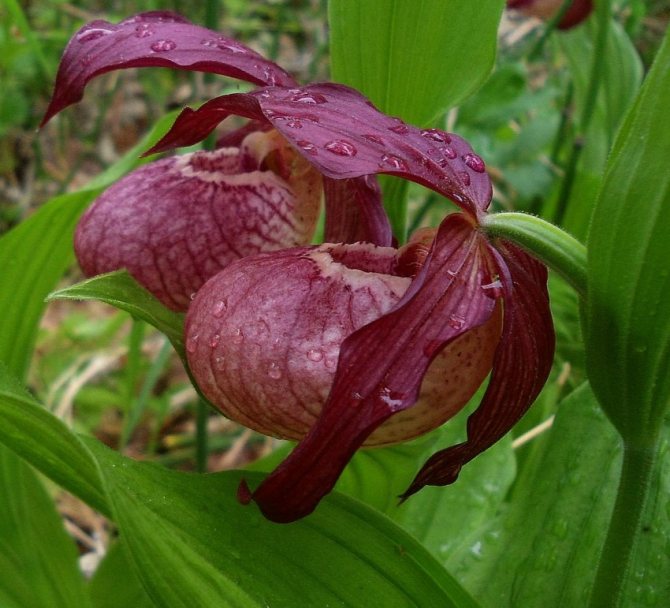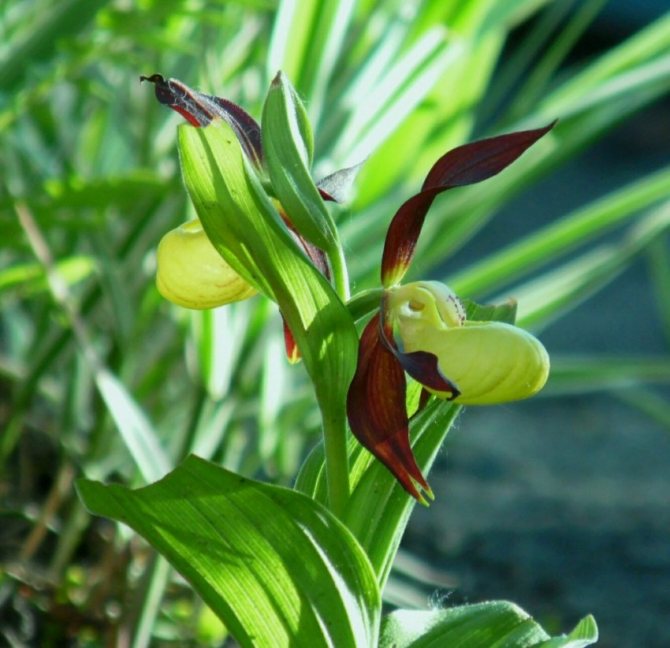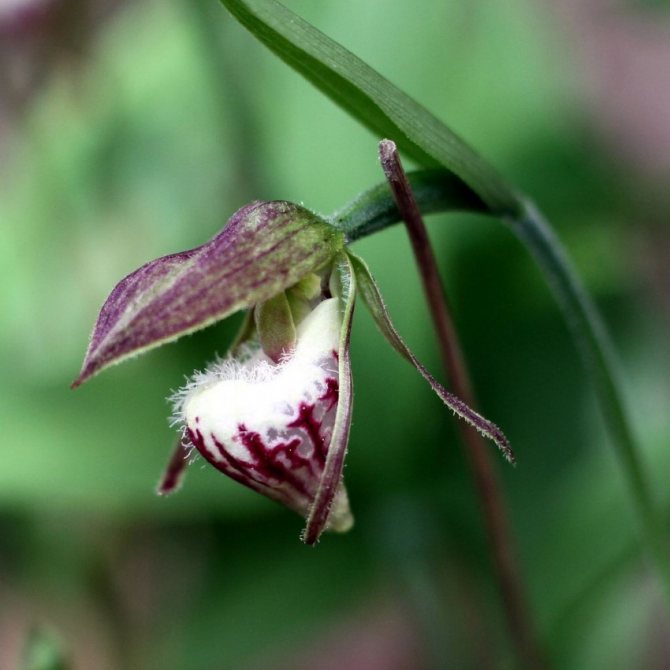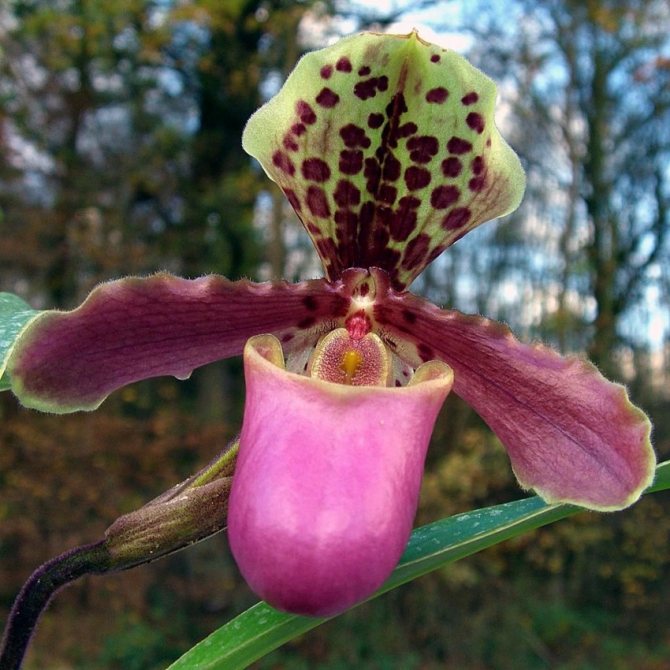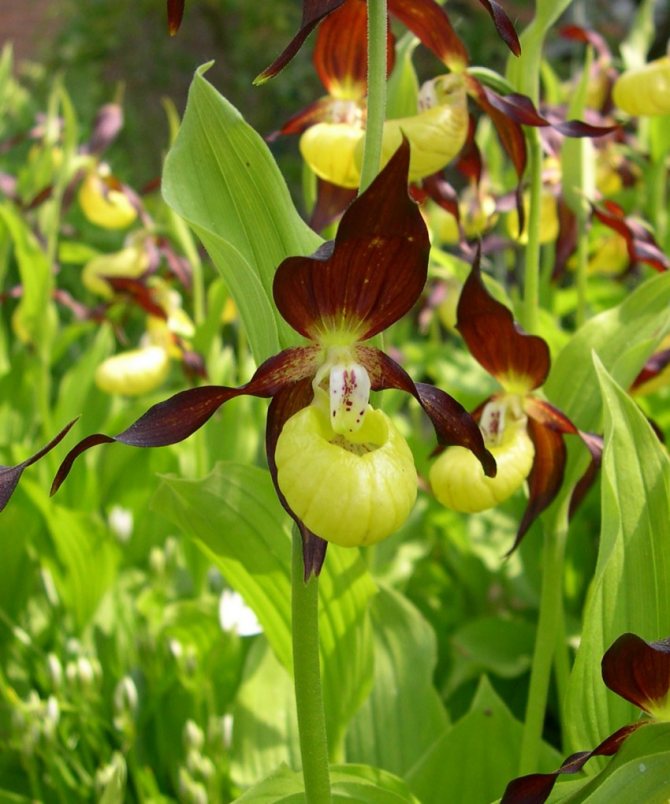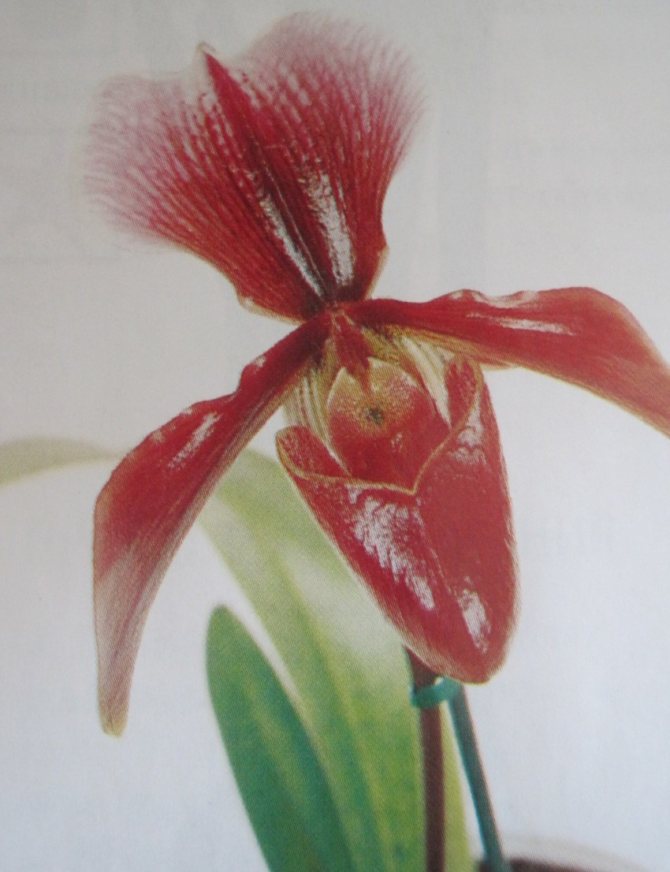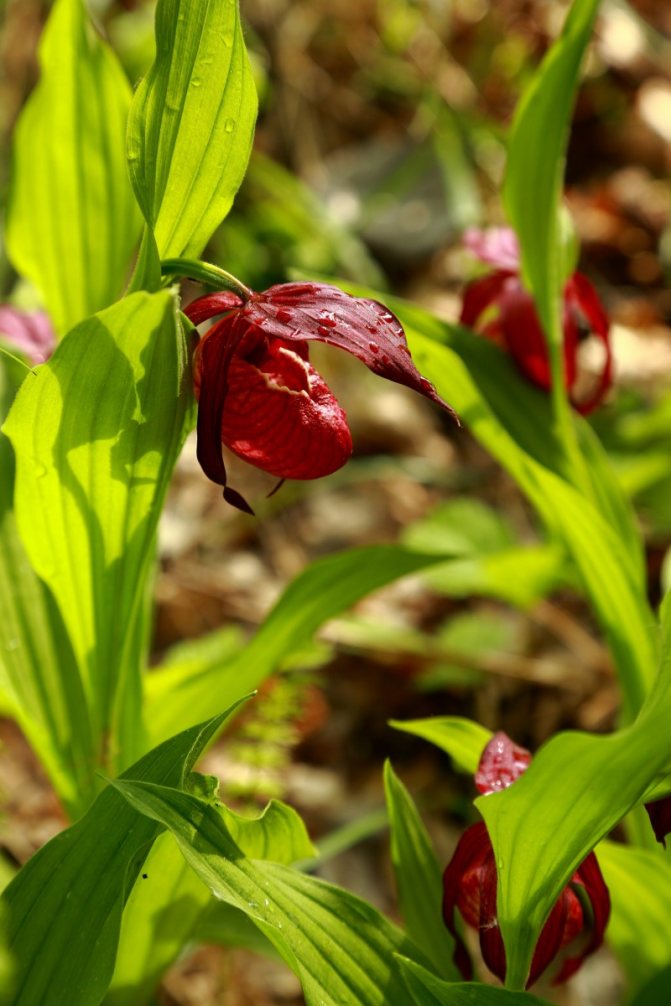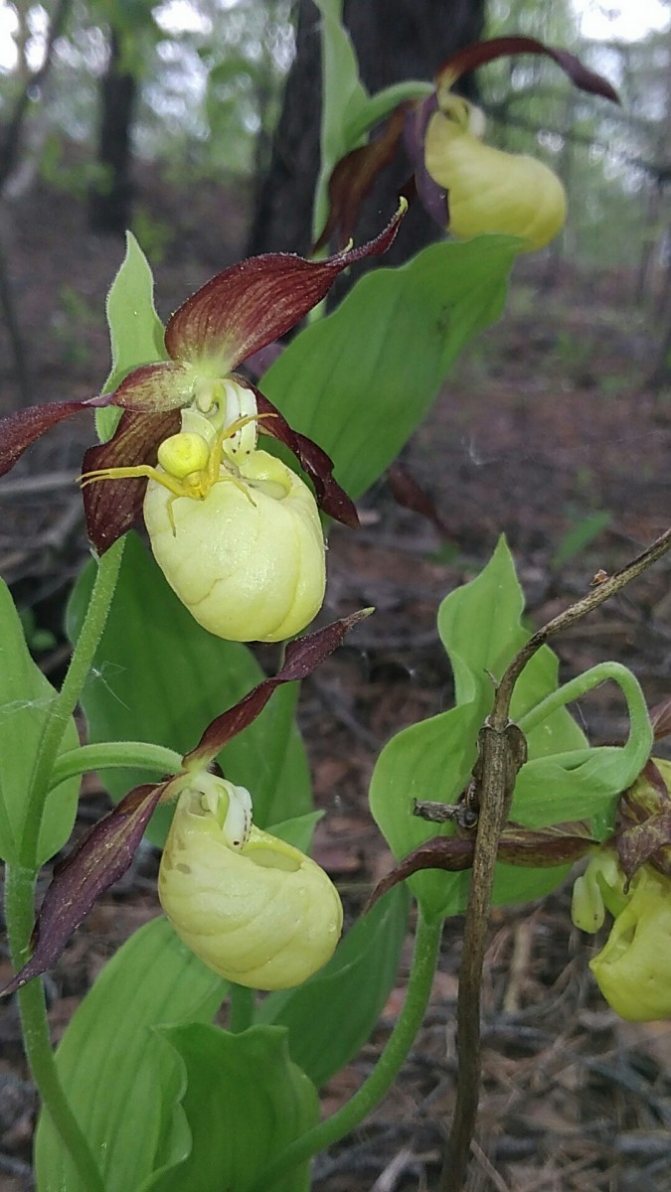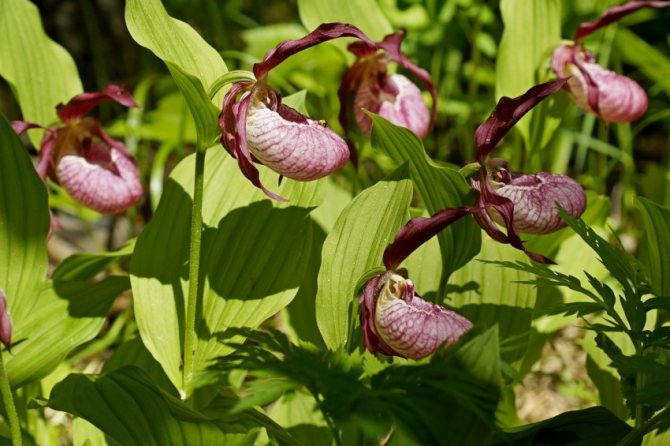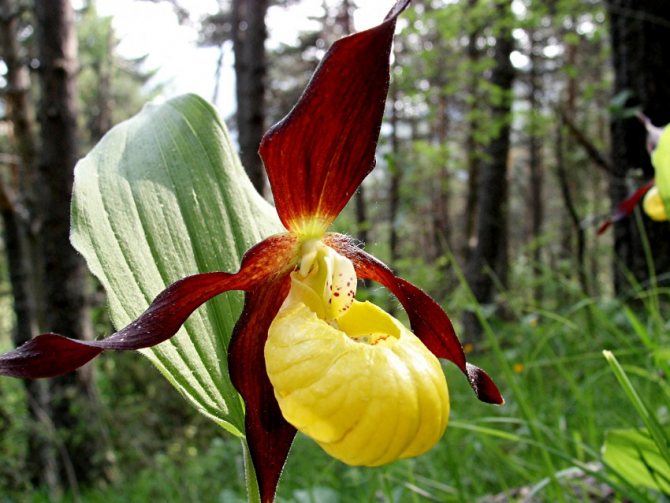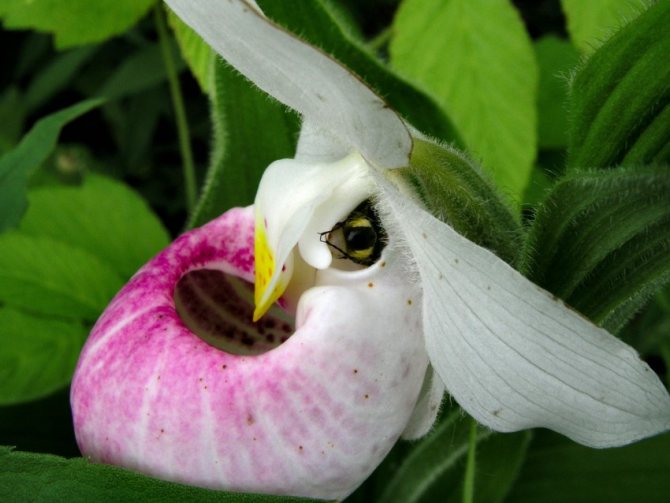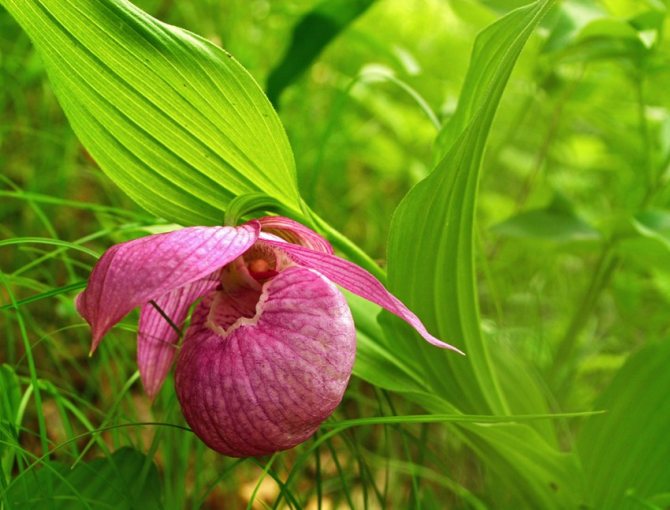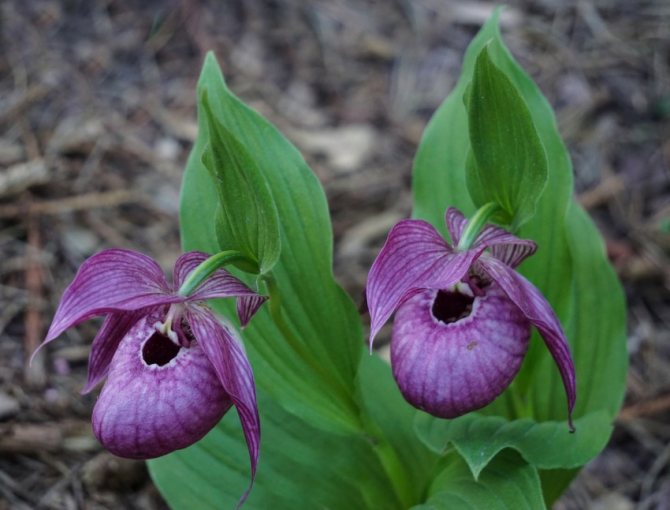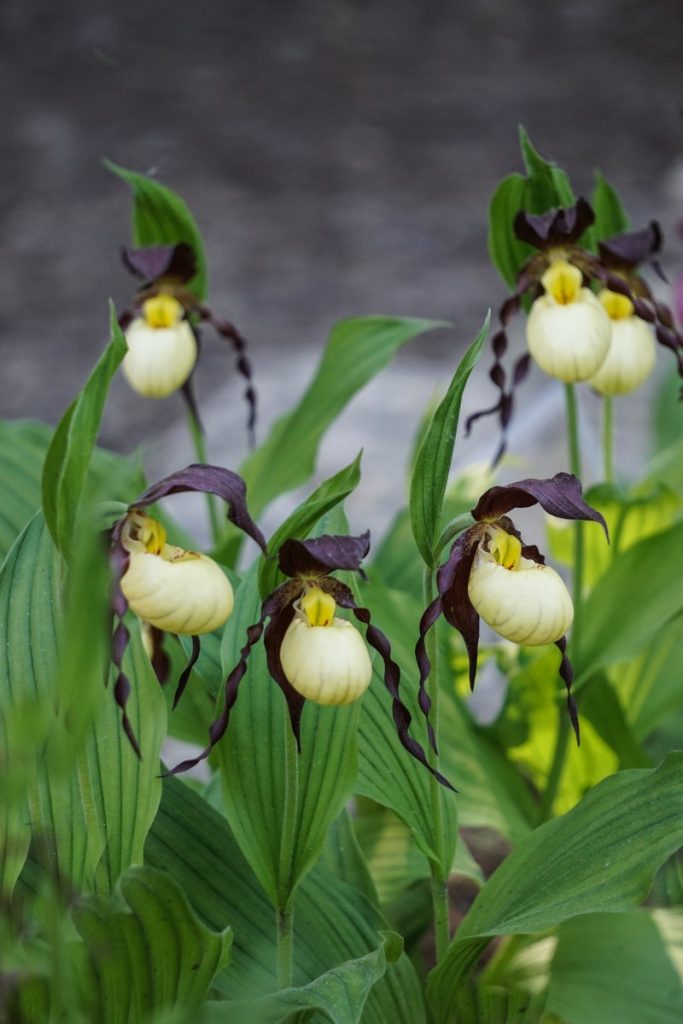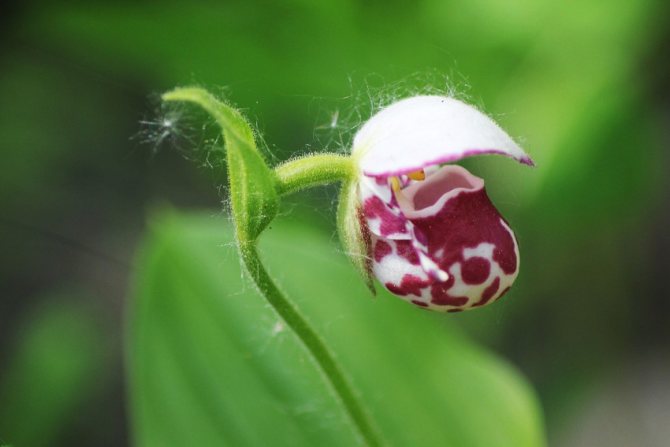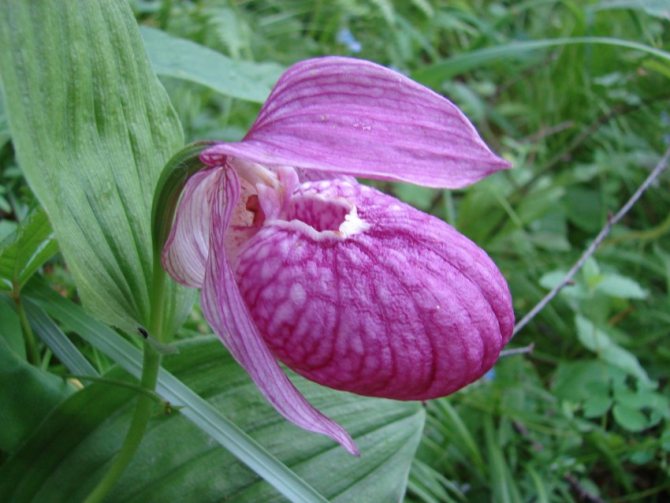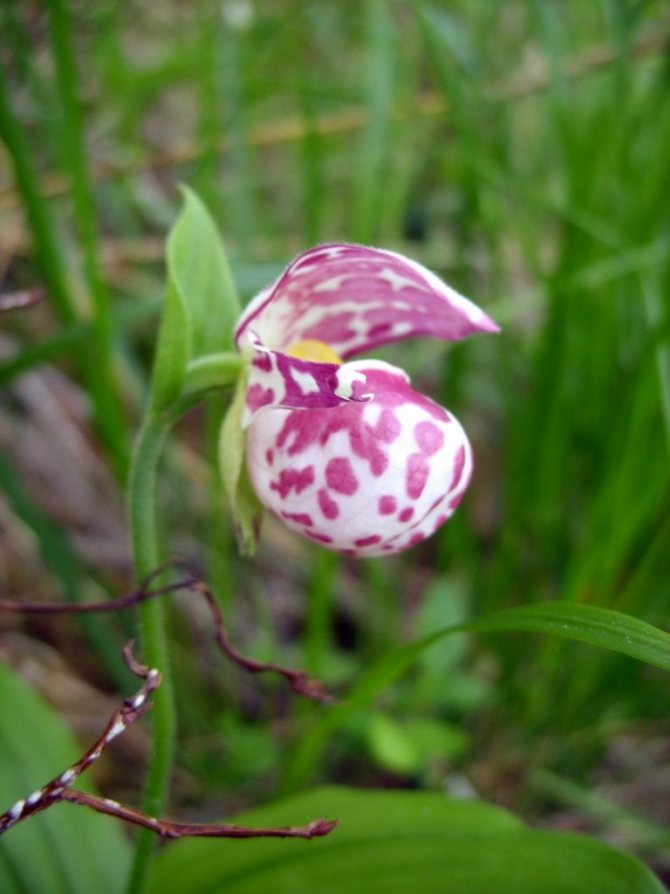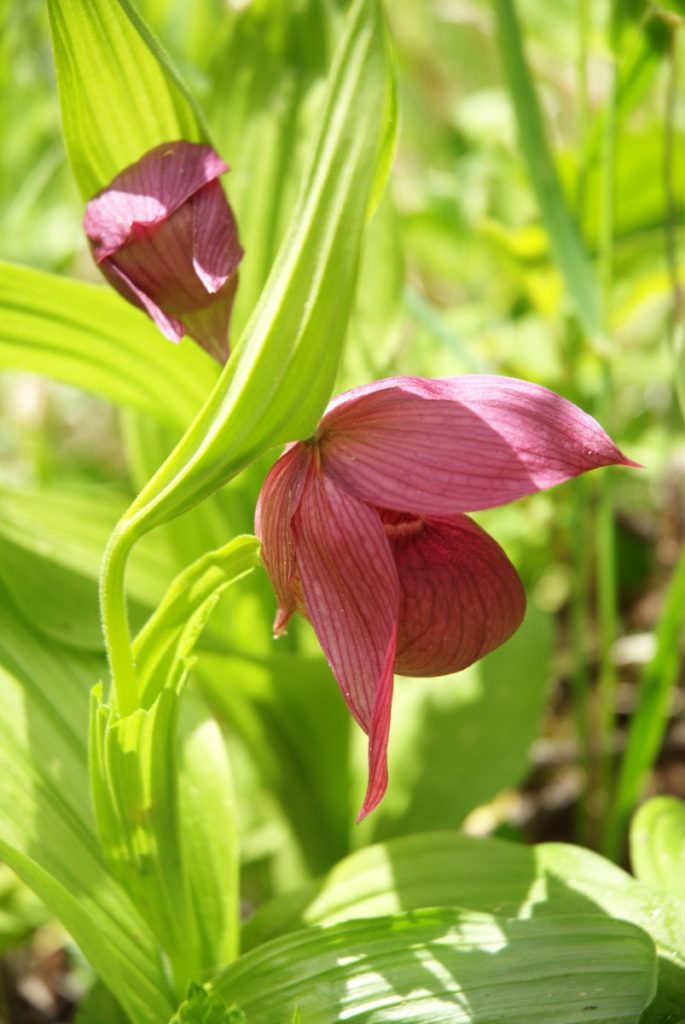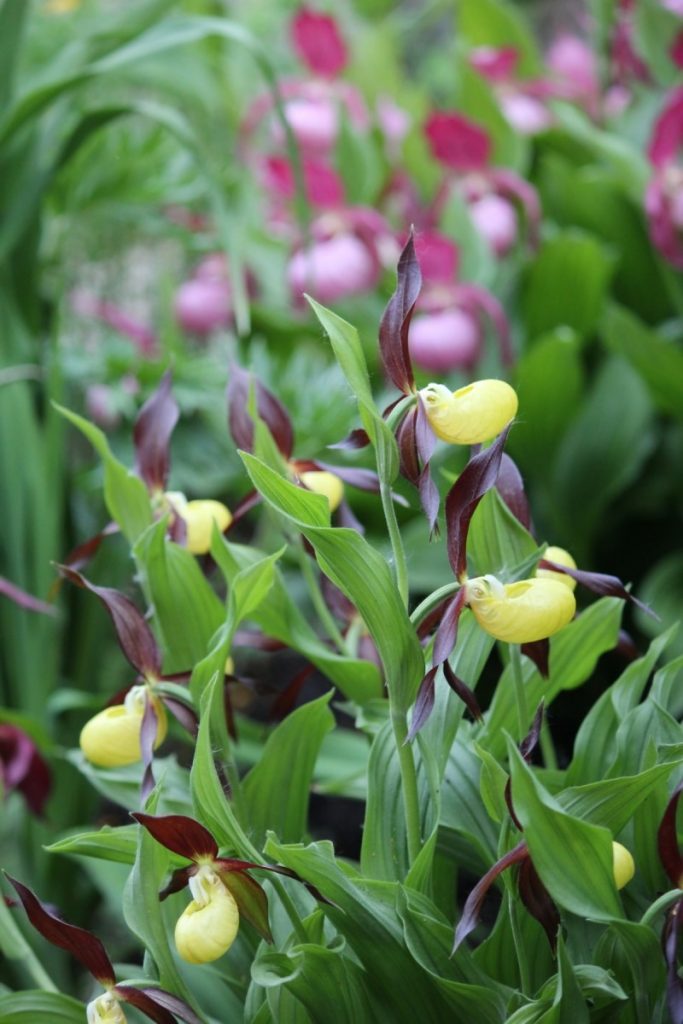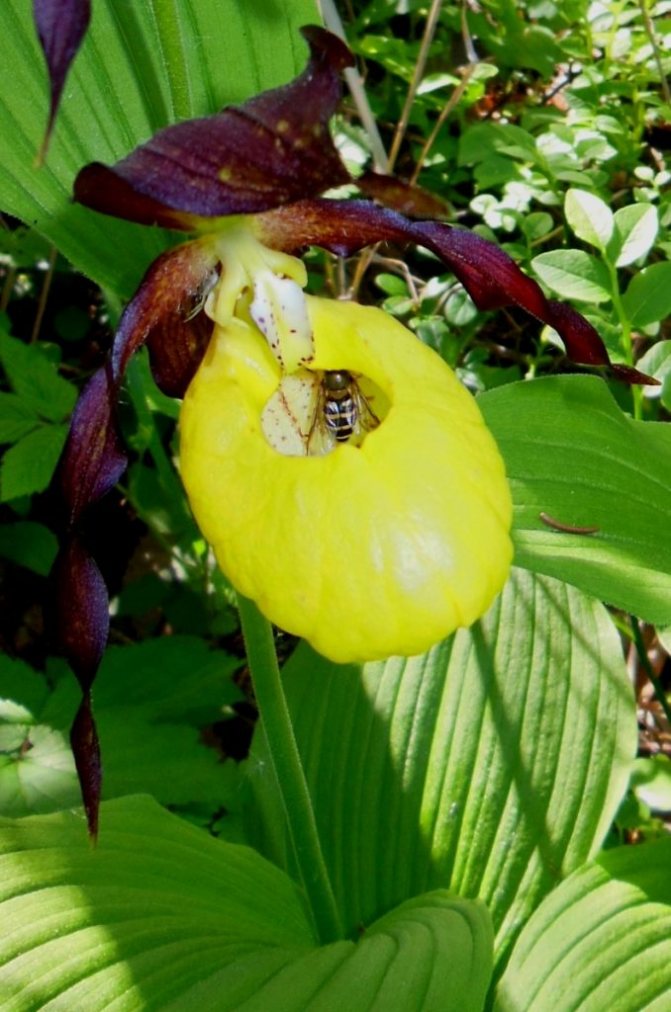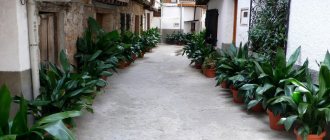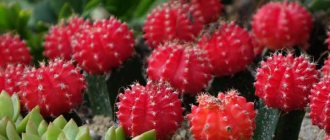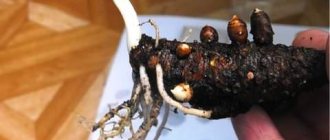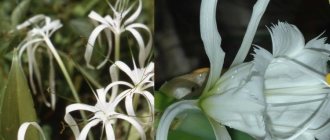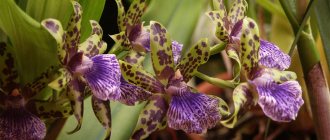Perennial plant of the Orchid family. It got its name for its resemblance to a shoe. Grows in warm to temperate, cool climates. Homeland is considered New Guinea, India, China, the Himalayas. In Russia, the places of growth are the European part, Crimea, the Far East, Siberia, the Caucasus. It is listed in the Red Book as an endangered species. The lady's slipper, photo and description of which are presented in the article, will decorate the garden and the house with its presence.
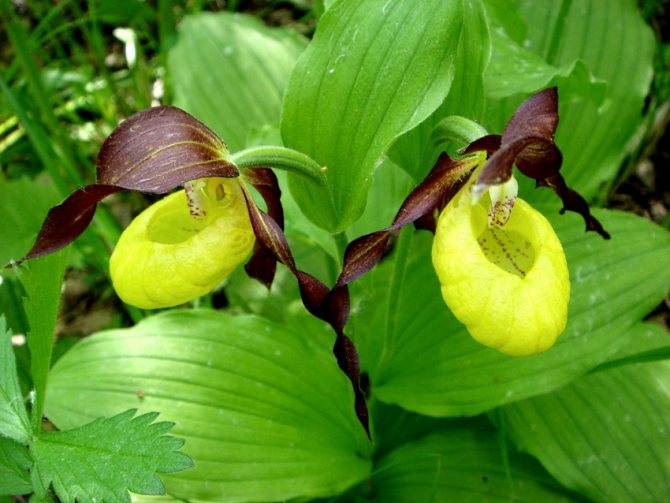
What kind of flower is a lady's slipper?
Flower characteristic
Paphiopedilum is a frost-resistant perennial plant that belongs to the Orchid family. The optimal habitat is highly moist, alkaline or neutral soil, rich in calcium and humus.
The orchid can withstand frost. It is known that under favorable conditions the evergreen slipper grows for a hundred years without a transplant. The native land of the plant is considered to be tropical Asia - Thailand, India and the Philippines. Different species bloom at different times. This type of orchid is rare and capricious, with home cultivation and reproduction, difficulties often arise.
What does a lady's slipper look like?
An amazingly beautiful and unlike anything flower Venus's slipper attracts the eyes of professionals and amateurs of flower growers. The shape of the flower is unique and memorable; it looks like a small shoe of a fabulous creature. Because of this appearance, an interesting name was formed.
The length of the slightly fluffy stem is 15-60 cm. In the middle of the stem, 3-4 wide elliptical pointed leaves grow in a spiral. The flower's lip color is yellow with red blotches.
beautiful and unusual flower
Where does Pafiopedilum grow?
The flower is common in Europe, with the exception of the northern and southern parts. Found in the Crimea, Sakhalin and southern Siberia, in the east and north of Kazakhstan in Korea, in the south of the Far East, on the Japanese island of Rebun. China, Malaysia and the Philippines are the best regions for flower growth.
The plant in nature is found in forests, shrubs, fields, on stumps. Wet soil is most comfortable for Venus's shoe. Fortunately, the lady's slipper lives well at home, so you can keep this delicate flower without any problems in your house or apartment.
When does the flower bloom?
The plant has a long flowering period, which can last several months in a row or all year round. Flowers perfectly decorate the living space. The slipper, like other types of orchids, responds positively to temperature changes day and night. From this they develop better and bloom richly.
Reproduction of plants is done by dividing the bush. It is better to leave a couple of sprouts on each branch. In this case, the orchid successfully adapts to the renewed environment and blooms beautifully.
Care
The lady's slipper gets along well at home and in an open area in the garden. Does not require much effort, unpretentious care. If all the recommendations are followed, the perennial will grow for a long time and bloom regularly.
Interesting Facts
Why is the lady's slipper listed in the Red Book?
The unique plant Venus's slipper has long been listed in the Red Book. And all because the flower is rare, it is in many parts of the world under special protection.
The point is in the extraordinary beauty of the flower - a person destroys it, as he collects for bouquets or gardens.Therefore, few specimens of this wonderful flower grow in the wild. The inclusion factor in the Red Book means that this species is endangered.
Legend
Ancient Greek myths reveal the origin of many natural phenomena, animals and plants. It is believed that the Venus slipper flower is nothing more than a modernized Venus shoe. Some sources say that Adonis and Venus took shelter from the rain and were carried away by lovemaking, taking off their clothes and shoes. When an ordinary person wanted to take a golden shoe, at that moment it turned into a flower.
According to another version, Venus traveled through the northern forests, all the surrounding nature rejoiced in her presence. Then the goddess lay down to rest without shoes, and when she left, she forgot to put on her shoes and her shoes turned into flowers. There are other versions related to the loss of her shoe by Venus.
Photo of a flower Venus slippers
Plant species
Lady's slipper is real
The incredibly beautiful plant Cypripedium calceolus L is 50 cm long and has a capsule fruit. The roots are creeping, thick and short, the root appendages are long and twisted, growing up to 30 cm.
The stems are covered with hairs, the lower ovary also has a downy. Sheet parameters - width 8 cm, length 18 cm, slightly wavy surface, elliptical shape with a pointed end. Bracts - foliate, large, zygomorphic flowers, both sexes. The perianth has brown and red leaves. The lip of the flower is light yellow, puffy.
lady's slipper real
Lady's slipper spotted
A small plant, Cypripedium guttatum, has long creeping roots in the soil. The height of the stems is 15-30 cm. The speckled slipper has elliptical leaves with a sharp tip, their length is 12 cm. There are hairs on the edges and veins of the leaves. Foliate bracts are lanceolate-ovate.
Blooming of the spotted shoe begins in late May or early June and ends in mid-July. Fruits appear in August and September. This species is valuable for breeding, has excellent decorative qualities. The spotted slipper is cultivated in many botanical gardens.
lady's slipper spotted
Lady's slipper large-flowered
The stems of the Cypripedium macranthos plant are 20 to 25 cm long, creeping roots, thin. The stamen in the flower is white speckled. Lip length - up to 7 cm, it is very inflated, in the form of a shoe with a small hole at the top. The edges of the lip are tucked inward. There can be 1-2 flowers per plant. They have an impressive size - their diameter is 10 cm.
At the peak of the flowering season, the flowers emit a pleasant vanilla scent. Flowers can be white, dark red or pink. An inflorescence is formed inside the bud 2 years before flowering. Roots grow slowly, up to 4 mm per year.
lady's slipper large-flowered
Garden lady's slipper
Cypripedium is grown in the garden. The plant tolerates being in the shade well. There are hybrid forms of cypripedium that are resistant to low temperatures.
Garden hybrids of the Venus slipper flower are optimal for growing in gardens located in central Russia. This area has a specific climate - in summer up to +30 degrees, in winter below -5 degrees. Orchids hibernate under the snow. Garden hybrids are grown from seeds, they successfully adapt in the soil, grow quickly and live for decades.
lady's slipper garden
Watering
There are two ways:
- from a watering can - until water begins to appear in the pan;
- with the help of a filled container - the pot is lowered to the level of the substrate and wait until the soil is saturated, then they take it out, let the water drain back, return it.
Water in the morning, with settled, boiled or rain water at room temperature, without salt impurities. After that, the moisture remaining in the leaves is removed with a dry napkin so that the roots do not rot. In summer they spend 1-2 times a week, in winter - no more than 2 times a month.
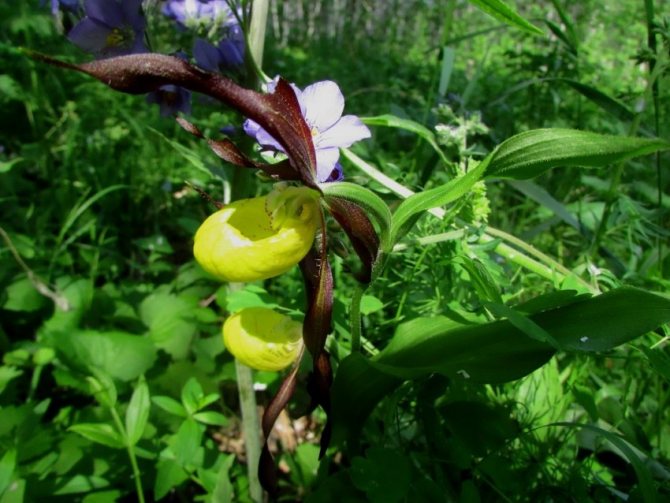

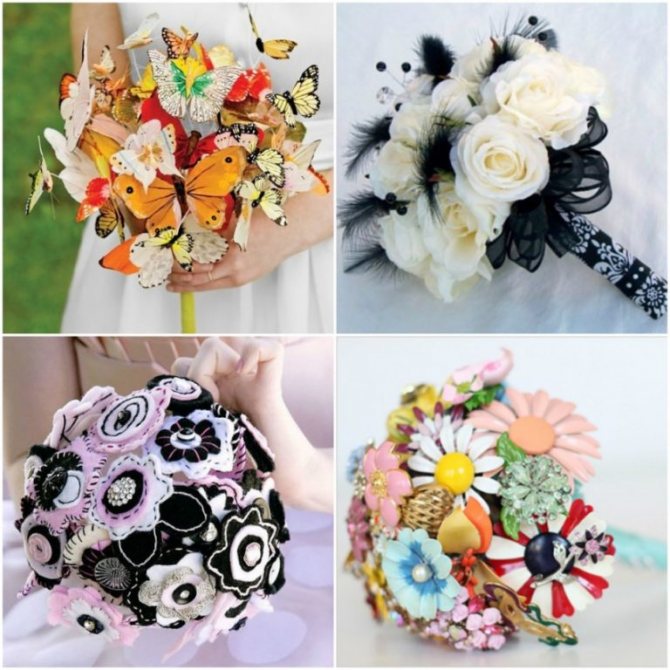

Do-it-yourself bouquet - a step-by-step master class for making beautiful bouquets of flowers (95 photos)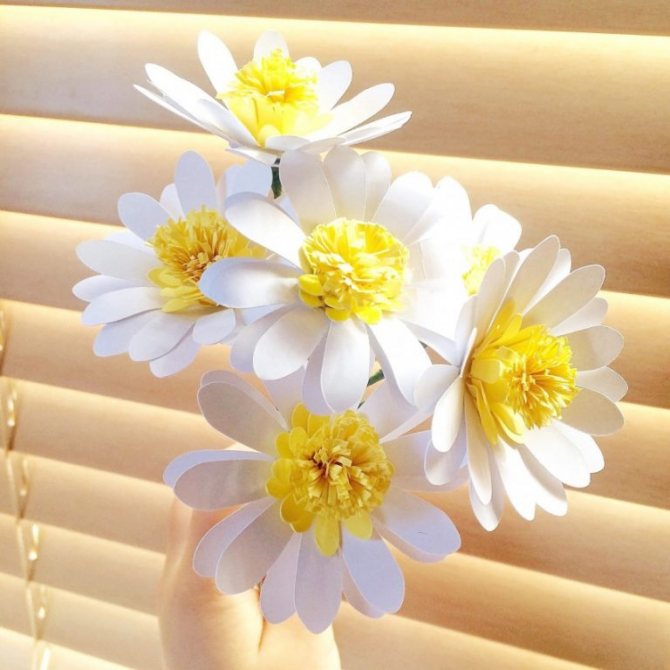

Do-it-yourself chamomile - detailed instructions, basic steps and tips on how to make chamomile (110 photos)
- DIY tulips - step-by-step instructions for beginners on making artificial flowers (110 photos and videos)
How to care for a flower at home or in the garden?
Priming
A good potting mix can consist of the following ingredients:
- chopped pine bark - 500 g;
- shell powder - 50 g;
- coal from wood - 100 g;
- perlite - 50 g;
- peat - 100 g.
We choose a wide, low container as a pot. We put a drainage layer on the bottom, then the prepared mixture of bark, coal, shells, peat, perlite. Before planting, we inspect the root system, remove the dead areas, then plant the plant in a pot.
Treat the sections with activated carbon. Only a dry plant can be planted. It is also important to set stops on which long shoots will be fixed.
Watering
Paphiopedilum requires regular watering, the schedule does not change in any season of the year. It is important to use settled, filtered or warm water. The optimum temperature is 30 degrees. It is necessary to ensure that the rosettes of the leaves do not get wet during watering, otherwise rotting may develop. If it happens that water gets on the foliage, you can wipe it off with napkins.
A convenient method of moistening an orchid is to place the pot in a container of water. After a while, the pot is removed. When pafiopedilum is in a mix of wood and peat, 15 minutes of exposure in water is enough. If there are coarse fragments in the soil, then it is necessary to increase the infusion time to 40 minutes. It is important to drain all the water from the pan to keep it dry. When the ground begins to dry out, the next watering is needed.
Temperature
Low temperatures are unacceptable for variegated papiopedilum orchids, they are thermophilic. All year round, in the room where the plants are located, you need to maintain a favorable temperature. The optimal temperature range for winter is 18-24 degrees, for summer - 23-27 degrees. Orchids with green large leaves are loyal to the cold.
For flowers, high temperatures are uncomfortable, which means that in winter you need to adhere to 16-20 degrees, and in summer 18-24 degrees. Temperature drops between day and night have a positive effect on orchids. Usually, flower growers keep the temperature higher during the day than at night by 5 degrees.
Air humidity
The natural habitat of orchids should be taken into account, they are comfortable in the forest, subject to high humidity, about 70%. It should be noted that growing a plant at home is characterized by the difficulty of installing the correct moist environment.
The modern lightweight solution is to install a humidifier that will maintain the optimum humidity level. The device benefits flowers and people. The second way out of the situation of too dry air is to lay moss or wet expanded clay in a container where a pot with a plant will stand. Thus, it will always be damp near the orchid.
Transfer
To understand whether a flower needs a transplant, it is necessary to evaluate its appearance. The fact that the time has come to change the soil is evidenced by the following characteristics:
- the substrate is too tight;
- the appearance of the orchid is unhealthy;
- the presence of mold;
- unpleasant rotten smell.
Florists recommend replanting Shoes every 730 days. As a rule, transplanting is done outside the flowering period. When flowering is complete, the orchid will take root better in its new habitat.
The development and growth of a plant depends entirely on the land used. The orchid is watered for the first time 3 days after transplanting.
Top dressing
It is ideal to use a store-bought fertilizer formulated for orchid growth. The solution is added to the soil every 30 days.It is also uncritical to use a fertilizer intended for flowering plants, but the dosage must be halved to reduce the concentration of the solution.
Infrequent introduction of organic dressings is acceptable. The latter are recommended to be used rarely due to the acceleration of substrate decomposition.
Growing in the garden
Interestingly, orchids planted in open ground begin to bloom only after 15-20 years. The plant can live from 30 years. There are a number of nuances for caring for a shoe orchid in the garden:
- cleaning of winter insulation and loosening of the adjacent soil is carried out in early spring;
- watering - regular, moderate (when the top layer of the earth dries out, but the deep layers are still wet, watering is needed);
- the land should be as clean as possible;
- it is important to prune the weeds in time (they are not pulled out, namely, they are cut so as not to harm the root system of the orchid);
- with proper feeding, intensive growth is guaranteed;
- the role of spring feeding can be played by the remains of mulch;
- the second fertilizer is relevant exclusively for honeycomb plants; it is applied in early May, not earlier (mineral complexes diluted with water);
- re-fertilization should be scheduled for the end of June, applied in the absence of flowers;
- oversaturation with nutrients is unacceptable;
- the end of August and the beginning of September is the time for pruning the orchid near the base;
- before winter - the plant needs to be mulched.
Humidity
Pafiopedilum is comfortable at 40-70%. Spraying the leaves is not carried out so as not to harm them. Supported by drainage in the pallet. When adapting, the leaves are wiped with a damp cotton pad.
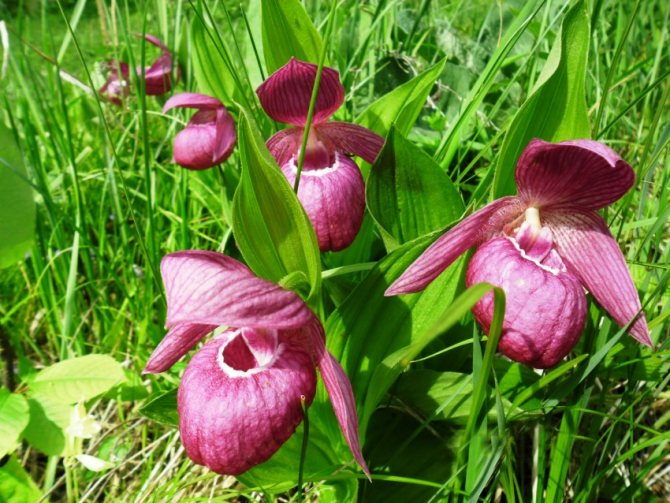

Exclude nearby heating devices.
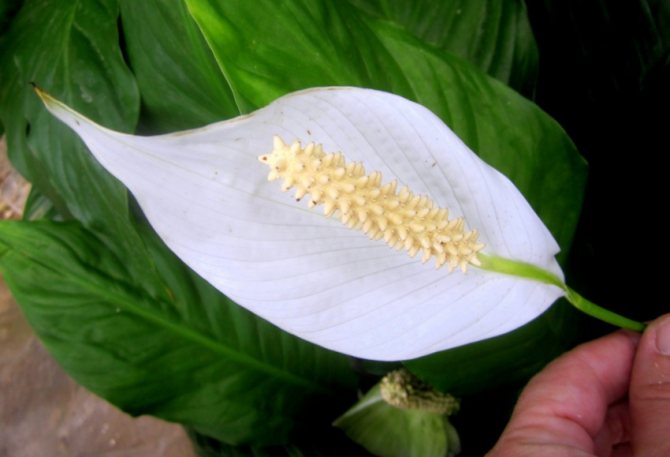

Flower female happiness: photo gallery with a description of the features of cultivation + signs and superstitions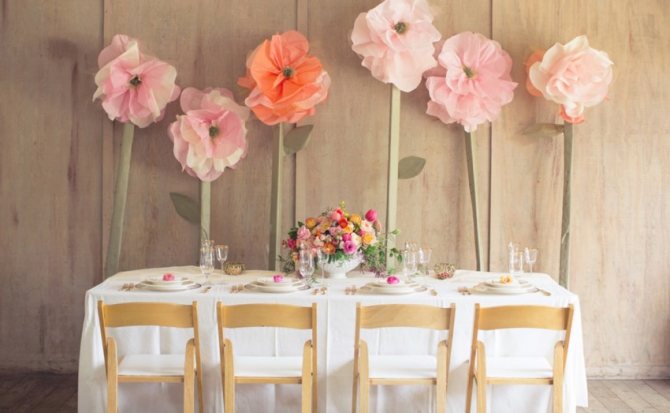

DIY flower decoration - step-by-step instructions on how to make a beautiful design (80 photos and videos)
- Do-it-yourself corrugated flowers - detailed instructions on how to make beautiful artificial flowers (75 photos)
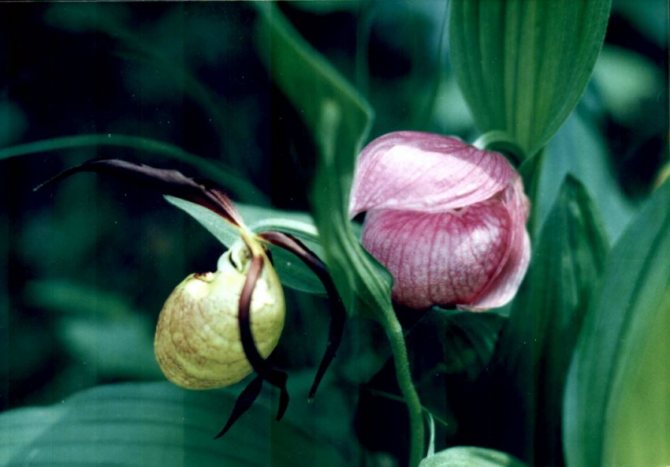

The legend of the lady's shoe
The flower got its name due to the shape of the bud's cup, which really has a certain similarity to a woman's shoe, and the petals nearby look like velvet ribbons. At all, this flower has other names:
- ladies' shoes;
- Bogoroditsin's boots (the name that is used in Russia);
- cuckoo shoes;
- moccasins (American version of the name of the flower).
Another legend about the origin of these flowers is described in ancient legends.
Once the goddess Venus and Adonis were hunting in the woods, but they were caught by a thunderstorm. Therefore, the lovers were forced to hide from the rain in a nearby cave. Before entering, Venus took off her wet shoes. But after a while a wandering traveler passed by, he saw unusual golden shoes and decided to bend over to pick them up and take a closer look at them. But as soon as he bent down, the shoes immediately turned into unusually beautiful flowers. So the traveler realized that the gods were hiding in the cave, and continued on his way. And since then, beautiful flowers can be found in the forests.
Orchid Papiopedilum, description
Paphiopedilum translates as "a slipper from Paphos" - the city in which the goddess Venus was born. The peculiarity and main decoration of the plant is an unusual flower that looks like a woman's shoe. In America this flower is called "moccasin flowers", and in England - "slipper".
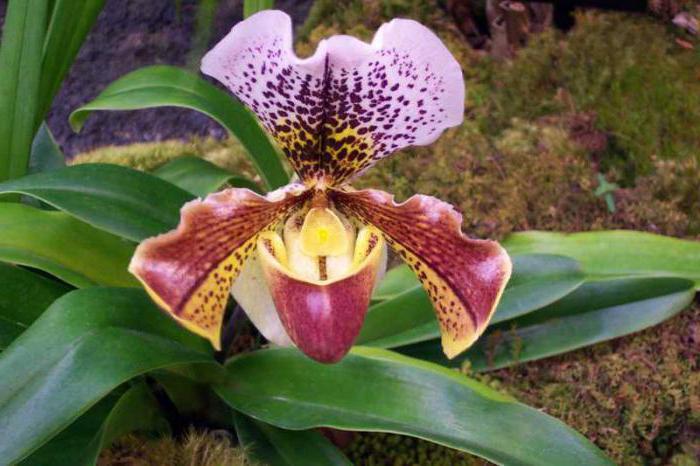

Papiopedilum is a terrestrial orchid, orchid family, sympodial. The presence of a displaced apical kidney is its feature. A pseudobulb with a dormant bud emerges from it and the plant develops. In Papiopedilum, instead of a pseudobulb, a leaf rosette forms on the roots. Leaves are oblong, belt-shaped. They can be leathery, soft and juicy, depending on the conditions of maintenance and the type of plant.
The flowers are of different colors, but mostly white, green, brown and yellow shades prevail.The petals are dense with a waxy coating or covered with fluff.
Paphiopedilum, the flowering of which depends on the species and variety, pleases with flowers for several months.
The flower has six petals, one of them differs from the others in size and shape, it is the "shoe of Venus". An erect peduncle rises from the rosette of the leaves of the plant, on which there are multi-flowered and one-flowered inflorescences.
The Papiopedilum orchid is demanding on the high humidity of the ground and air in the apartment, it tolerates slight shading and high temperature quite calmly. Copes easily with short-term droughts thanks to juicy and leathery leaves that are able to accumulate moisture.
Description of the plant
Flower lady's slipper - perennial plant, herbaceous... It belongs to the Orchid family, of which there are more than 500 varieties. Leaves are green, sometimes with a grayish tinge and marbled pattern, up to 30 cm long. From each rosette of leaves comes one 40-cm peduncle with one or more flowers.
Flowers can have a wide variety of colors: yellow, white, purple and even brown or greenish. They also have a pleasant vanilla scent that attracts the pollinating bees. Sometimes you can find flowers decorated with spots or stripes.
Very often, the stem is covered with fluff and can be very short, in which case only one pair of leaves flaunts on the stem, located close to the ground. In specimens with a high stem, the leaves are large, arranged in an alternating order, the tops of the peduncles are crowned with up to 12 flowers with a complex structure, which can become a trap for small insects. However, nature is prudent, and they can escape through small holes in the back wall of the calyx after pollination. After pollination, a real lady's slipper begins to fade slowly.
By the end of summer, many small seeds ripen, very tiny, like dust. Most of them will scatter through the air without touching the soil. The same seed that manages to reach the ground will germinate if symbiont fungi are present in the soil, penetrating into the embryo of the grain and activating the processes of sprouting and further growth.
Wildlife
One of the interesting facts is that the lady's shoe takes many years to bloom. To protect against the possibility of being eaten by someone, nature has endowed this flower with a poisonous juice with a pungent odor. But for a person, it is not dangerous, on the contrary, it is widely used by folk healers.
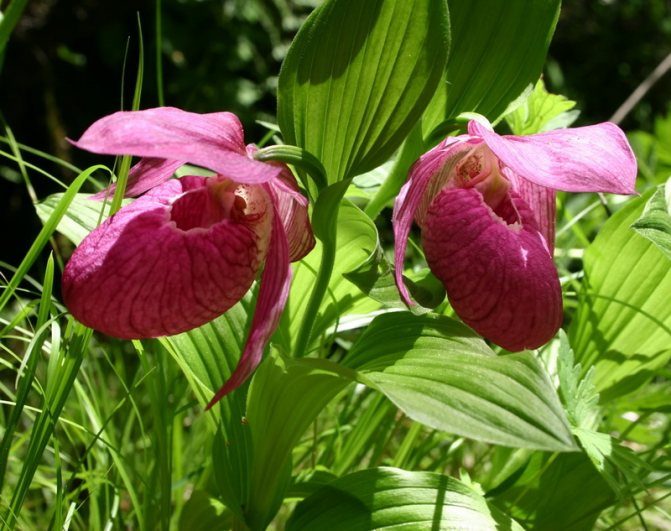

Lady's slipper grows in groups in places with low light and where there is a lot of moss and shade from trees. He also feels good in ravines, river cliffs, in forests with coniferous and mixed species of trees, in highly moist soil, rich in lime.
In Russia, this flower is very rare. It is more common in South and North America, the highlands of China, Mongolia and Japan.
Known species and varieties
Initially, there were many varieties of Venus shoes in nature., however, over time, their number has decreased. Some of them are popular with gardeners, others can only be found in natural habitats:
- The lady's slipper is real. It is grown not only at home, but also actively used for medical purposes: it is able to cure some mental ailments, epilepsy and relieve headaches. This species has a horizontal root, rather thick, from which 40 cm shoots emerge. It differs from other brethren in color - the lower cup-shaped petal is yellow, and the other petals are brown-red. It begins to bloom in mid-May and ends in August.
- Large-flowered. It earned the name due to the large size of the lower petal. It looks somewhat different from the rest of the species: the petals are not elongated, but oval, resembling leaves in shape, sharpened at the ends.They can be of different colors: purple, pink, lilac shades, sometimes with specks. On the cupped petal there is very often a pattern - dots and specks.
- Spotted. This is the most frost-resistant species. Therefore, it was appreciated by amateur gardeners of the northern regions. Its peculiarity is its simplicity to the composition of the soil. He feels comfortable both on fertile soil and on poorly fertilized soil. This is a short flower - from 10 to 30 cm. The color is white, with purple blotches. The lower petal looks like a platform shoe. New shoots grow from the rhizome once a year at a distance of 10 cm from each other. This greatly facilitates the process of transplanting to the site.
- Acaulescent. It has an interesting aromatic scent. It was first discovered in America in 1789. It is very difficult to grow it on your own. But with careful recreation of natural conditions, he will feel comfortable. The flower has thick, oblong leaves with folds. Sometimes small leaves are present on the peduncle. The lower petal is small - only 5 cm, there is a longitudinal fold on it, which creates a feeling of duplication. It comes in pink and white.
- Californian. Perhaps the most exotic and striking representative of the species. It grows only in Oregon and in the mountains of California. Resistant to external factors, but prefers extremely humid places. It has a small "lip" of a delicate beige color and yellow petals on the sides. Grows up to 90 cm in height. One shoot can accommodate up to 12 flowers. It is noteworthy that they do not smell.
- Tufted. Can often be seen in the forests of western America. Stunted - up to 40 cm. The stem is covered with short hairs, below there are two basal leaves, above which there are greenish flowers. Cup-shaped yellow-green petal with purple splashes.
- Ram-headed. It grows in moist and warm places. Its height is up to 30 cm. It has weak thin leaves and stems. The flowers are small, located singly at the tops of the stems. There are red and white, white and purple colors. It begins to bloom in July.
- Snow white. Natural habitat - marshlands and humid meadows of America. These are medium-sized plants growing up to 30 cm in height. The rhizome is short. There are 4 elongated and pointed leaves near the stem. Sepals are green, covered with purple specks. The cup-shaped petal is white. The beginning of flowering is the end of spring.
- Queen's slipper. It is a tall 60-centimeter plant with a small rhizome. The stems are strong, covered with hairs that resemble down. Leaves are oval, 25 cm long and 10 cm wide, light green. Flowers are 8 cm, white or pink. The "lip" is swollen, white with purple splashes. It begins to bloom in July. Resistant to frost up to -40 degrees.
- Fluffy. It is found in swampy and damp places. Height - up to 50 cm. There are 4 leaves at the bottom of the stem. Most often, the flowers are solitary, sometimes up to 3 flowers grow on one stem. The sepals are green. The lower petal is bright yellow or light green, with red veins.
- Small-flowered. Grows in mountains and wetlands. The height is only 7 cm. At the bottom of the stem are medium-sized oval leaves. The top is crowned with two flowers exuding a pleasant aroma. The sepals are purplish green. The "lip" is bright yellow, swollen and slightly compressed. The flowering period is from May to July.
Description
It grows up to 20-25 cm. The root system is located on the surface layer of the earth. Green color predominates. In the process of growth, aerial roots appear. The leaves are large, belt-like, up to 30 cm in length, grow in rosettes from which the peduncle emerges. The flowers are single with a bright varied color. The lip is similar to a shoe, two-bladed, interspersed. Lanceolate side petals, slightly twisted. The upper one is large, the lower one consists of two, fused into one.Its structure resembles a flower-trap, at the bottom of which there are hairs that secrete nectar to attract insects. Has a pleasant aroma.
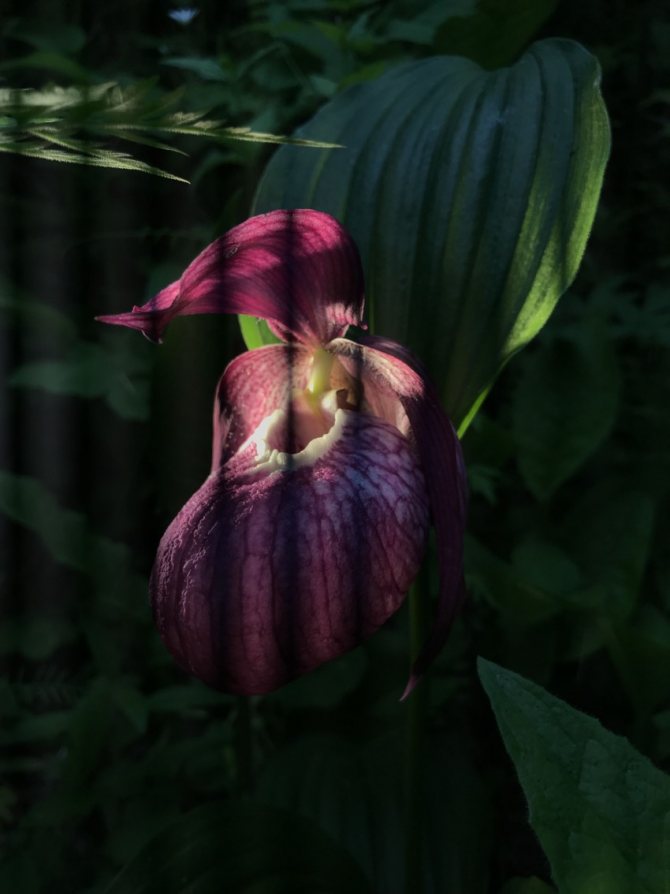

Lady's slipper: 19 photos with a description, features of cultivation
Orchids - plants of extraordinary beautythat are found in our flora. They always attract special attention to themselves. In a bouquet of flowers, it is the orchid that takes the central place.
In nature, there are about 150 species of this amazing flower.
The habitat of orchids stretches from the tropics to the temperate zone... Wild plants have adapted to adapt to certain climatic conditions, and this is reflected in the shape and shape of the inflorescence.
Fertilizer
The composition of the feed includes:
- nitrogen;
- potassium;
- phosphorus;
- trace elements.
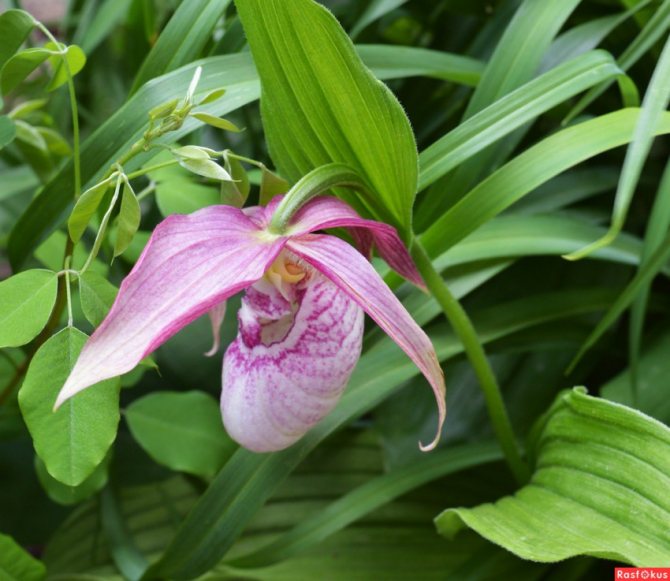

Only used for healthy orchids. In the spring, during the period of active growth, fertilize twice a month, alternate organic matter and mineral fertilizing. In autumn - no more than once a month, the substrate is regularly washed to avoid the accumulation of salts. In winter, the flower goes to rest and does not need additional fertilization.
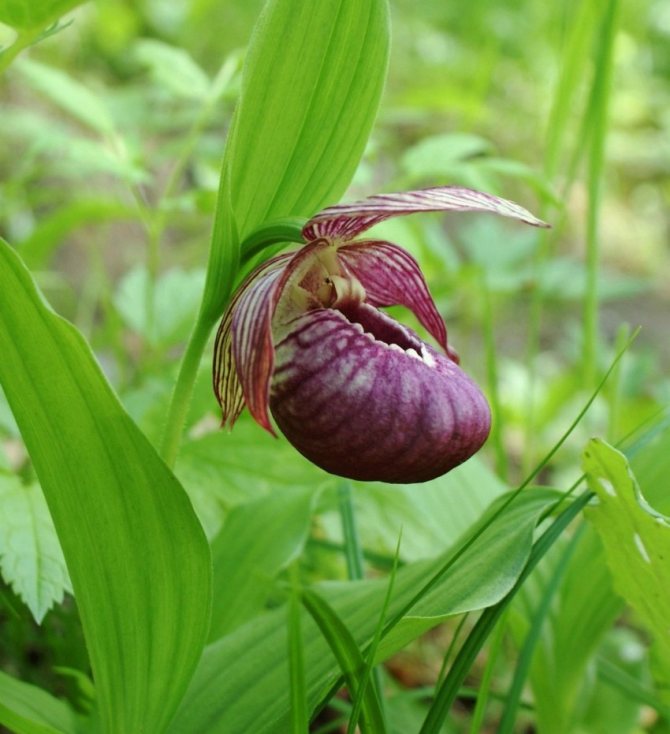

Origin and name
Orchid name "Venerin's slipper" is rooted in a very romantic legend. In ancient Greek mythology, there is the legend of the goddess of love Venus, who, walking through the fields and forests, dropped her shoe from her foot. The traveler saw the shoe, picked it up and held it out to the goddess. But at that moment the shoe turned into a plant with a very unusual appearance.
Another beautiful legend tells that during the hunt Venus and Adonis got caught in the rain. They took refuge in a cave, where they indulged in amorous pleasures, and a slipper, which was made of pure gold, slipped off the goddess's foot. A local shepherd found a shoe, but as soon as his hand touched it, he took the form of an exquisite flower in the form of a shoe.
Flower pot
To grow Pafiopedilum orchids (home care for which is not particularly difficult), clay or plastic pots are used. The walls of the pottery have pores and allow air to flow to the roots of the plant, but the substrate dries out quickly in it. In transparent plastic, it is good to control the root system, but the walls of the pot can become green, so it should be placed in a planter. The plastic container is convenient for transplanting, it is easy to remove the plant from it.
For the convenience of transplanting, the neck of the pot is always wider than the base. At the bottom of any flowerpot there should be a hole for the drain of excess water, and if it is high, then holes are made from below in the walls.
A variety of Venus Slipper hybrids are available at flower shops. Their appearance is very unusual, they really look like real little shoes. The long flowering of this plant adorns the home and pleases the eye almost all year round.
Photo and description
The perennial "Lady's slipper" belongs to the orchid family... You can meet this unusual flower in the European part of Russia. It is widespread in the Crimea, southern Siberia, northern China and Mongolia, Europe, and is also especially revered in Japan.
The root system of the flower is thick and short, but with many small roots on the main root. Stems can grow up to 60 centimeters, more often they are of medium length (20–35 centimeters). The number of leaves ranges from 2 to 10. They are wide in the form of an ellipse with pointed ends of yellow-green color, stretching from the base to the inflorescence itself. The edges of the leaves are even and smooth.
However, it is not only the unusual shape of the flower that attracts, but also a delicate sweetish pleasant aroma. The color of the petals of an orchid can be bright yellow or lemon, and the perianth is brown-red.
Bloom begins in July - this is the most wonderful time when you can see all the beauty of a flower. Pollination occurs with the help of bees, hoverflies and insects. The flower consists of 3 petals and 3 sepals. Using an outlandish plant shape, spiders love to set traps for their victims here.
The age of a flower is easy to determine by the number of leaves, there should be at least five of them. To speed up flowering, the "stress" method is sometimes used. For example, you can create a difference between day and night temperatures of 4-8 degrees.
Diseases and pests
Leaves and roots are especially susceptible to damage. The reasons may vary. If the leaf plates darken, there is an excess of fertilizer or anthracnose fungus. The fall of unblown is caused by the fungus Botrytis. Yellowness and shedding is a natural process.
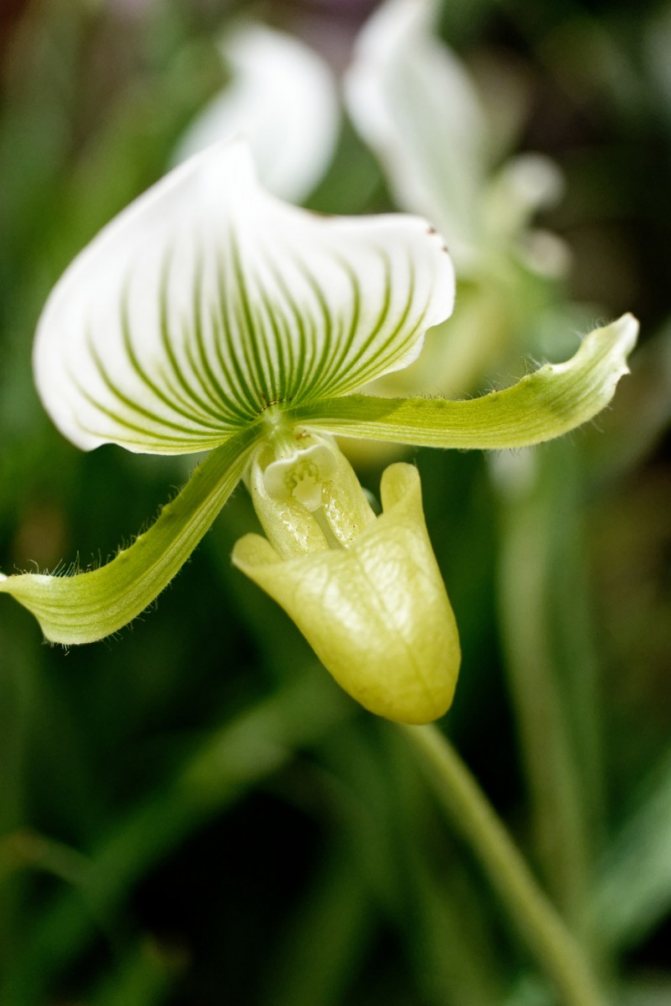

The root system rots as a result of excessive watering, which causes the appearance of fungi that cause various diseases (fusarium, late blight, pytium, rhizoctonia).
There are dark spots on the petals and lip - cold in the room, low temperature and high humidity. Of insect pests, one should be wary of a mealybug, spider mite, and scale insects.


Varieties of the orchid "Lady's slipper"
The slipper or its botanical name "Papiopedilum" has various artificially bred varieties. The papiopedilum species is divided into 4 genera, each with several dozen subspecies.
Lady's slipper, real or ordinary
This is a rare perennial plant that is listed in the Red Book.... It is found in deciduous or mixed forests, where there is a lot of moisture. Propagated by vegetatively separated shoots. Seed propagation is difficult due to the peculiarities of the size of the seeds: they are so small that they disperse like dust before reaching the soil. The stem height ranges from 15 to 40 centimeters. During the flowering period, 1-3 large bright yellow flowers appear at the top.
Acaulescent
It has two tubular leaves and one large flower with a pleasant aroma on one stem. The flowering period lasts from late spring to mid-summer.
California lady's slipper
The giant among all varieties of papiopedilum. The stem height reaches 80 centimeters. On a massive stem 3-4 leaves of an oblong shape are placed. One inflorescence can contain from 4 to 12 small flowers.
Large-flowered
This orchid species has only one flower pod with a pouting purple veined lip. The flowering period is mid-summer.
Lady's slipper cypripedium guttatum or speckled
It is found in the European part in the middle latitudes, in Siberia and the Far East. The stem height is no more than 30 centimeters. It begins to bloom in May - June... This species is well acclimatized in any soils and is able to decorate not only a greenhouse, but also an alpine slide, a garden of stones in garden landscape design. The flowers have an unusual color - spotted purple.
Ramhead
Named so for the shape of small single flowers on a thin stem.
Snow white
A rare variety with 2-3 elongated white flowers, and with a stem height of no more than 15-20 centimeters. Has a unique aroma.
Knotty
The stem of this type of shoe reaches 40 centimeters, and at the end there are 4-7 inflorescences.
Pafiopedilum concolor
The wild plant is found in Asian countries: Thailand, North Vietnam, China. It grows on the banks of rivers, loves high temperature and humidity.
Paphiopedilum micrantum small-flowered
A single flower with an incredibly large velvet lip. It is the most recognizable of the orchid family. The homeland of this plant is the humid mountain forests of southern China.
Paphiopedilum niveum
It grows in Malaysia and southern Thailand. It has large white inflorescences with variegated green leaves.
Priming
They are planted in a mixture of peat and pine bark in a ratio of 1: 3. River sand, humus, coal, chalk are added. Moss is spread on the surface to maintain the moisture level. The pH is neutral or slightly acidic.
Planting and care at home
This exquisite flower is less finicky than violets, begonias or fuchsias. With proper care, it pleases with long flowering.
Watch the video for caring for this type of orchid at home
Tips for growing and caring for a shoe at home
Paphiopedilum grows well in pots on the windowsill if several prerequisites are met:
- Preference should be given to slightly cool, well-ventilated areas with ample sunlight.... The temperature regime should not exceed 20 degrees. In the warm season, the room where the orchid grows must be periodically ventilated. The humidity indicator can be in the range of 50–70%. Watering should be done as the soil dries, but not overdry.
- A lady's slipper in a greenhouse and at home blooms in winter, therefore, after flowering, watering should be moderate, and moistening should be done with a sprayer in the smallest drops mode. The lifespan of the plant and flowering depends on competent watering. The orchid does not tolerate waterlogging... In summer, the flower is watered twice a week, in winter - once; between waterings, the soil should remain completely dry.
- Orchid feeds are selected depending on the stage of growth. Fertilizers needs to be applied only through watering... After transplanting, it is not recommended to feed the flower for a month. During the "rest" period, after flowering and during flowering, the plant is not fertilized.
- Reproduction of pafiopedilum is carried out during transplantation... The plant is divided into several parts with roots and shoots. Young orchids are planted in clay pots with a diameter of at least 10 centimeters. A drainage made of polystyrene, expanded clay, crushed stone is placed at the bottom of the container, pouring a little soil. Then the roots are placed, and the top is filled with a substrate. The planting pot is placed on a windowsill away from direct sunlight. After 2 weeks, the plant can be sprayed.
- Orchid transplantation into fresh soil should be carried out no more often than every 2-4 years... When changing the soil, the process of "getting used" to the composition of the substrate takes place. To make this period less painful, it is necessary to leave some of the old soil in the pot. The planting pot should be 5-8 centimeters larger in diameter than the previous one. The best time to change the soil is the dormant period of the flower culture, after flowering... It is not necessary to water the plant during transplantation, since there are enough trace elements and moisture in the new soil composition.
Special balanced substrates are available from flower shops. They must be nutritious and permeable to moisture and air. During the peduncle period, you should not carry and move the container with a flower, every movement for a light-sensitive plant causes stress.
In order for flowering to last as long as possible, during the swelling of the buds, it is necessary to double the number of waterings. During the flowering period, the room temperature should be increased by 6-7 degrees.
When placing the pot on the north side, the flower will feel a lack of light, and additional lighting with phytolamps will be required. The most optimal choice of place is the eastern and western sides: the flower will bathe in the gentle rays of the rising or setting sun.
Lighting
Light is scattered, preferring east, west or north. Shade on the south side. They gradually get used to a new place. Sun and shade alternate for three weeks. If the leaves have acquired a purple hue, then the lighting is too bright and the intensity should be reduced.
Daylight hours last at least 16 hours, if necessary, artificial lighting is organized.
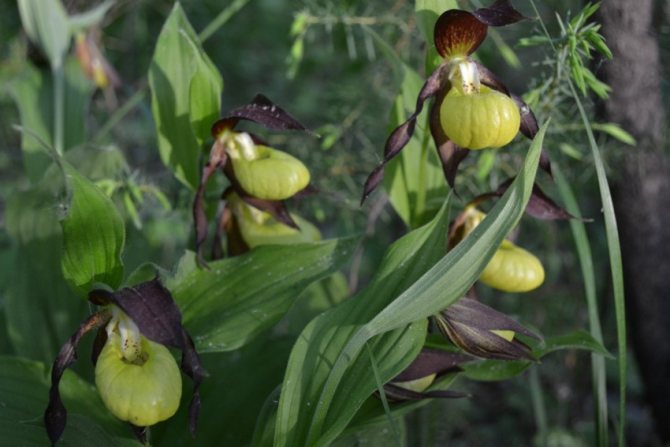

Protection from pests and diseases
The immune system of papiopedilum is quite resistant to diseases and pests. But from over-watering or contaminated potting soil, harmful microbes can form.
For the prevention of diseases, before planting, the pots are disinfected, and the plant is treated with a biofungicidal agent phytosporin... At the first signs of the appearance of brown spot on the leaves, the damaged parts are removed from the stem. The container with the flower is transferred to a dry, ventilated room.
Papiopedilum pests: what they look like
The most dangerous for the flower culture are:
Small insects are located on the perianth and stem of the plant. In the fight against them, spraying with a solution of karbofos helps.
Transfer
Young people need it once a year, adults - once every 3 years, in the spring. Reasons why they are transplanted:
- renew the substrate;
- increase the volume of the pot;
- eliminate a pest or disease;
- preserve the plant that was poured during watering.
Water abundantly the day before. On the day of transplantation, the pot with Paphiopedilum is placed on its side and the side parts are freed from the walls with a knife. The old soil is shaken off, long non-functional roots are cut off, covered with ash.
New dishes are chosen with a diameter of 5 cm larger. A quarter is filled with drainage, then the substrate is gradually laid, compacted. The top is covered with a 2 cm layer of moss. Put in the shade, monitor the moisture content of the soil. After three weeks, new roots will appear, it is returned and looked after as usual.
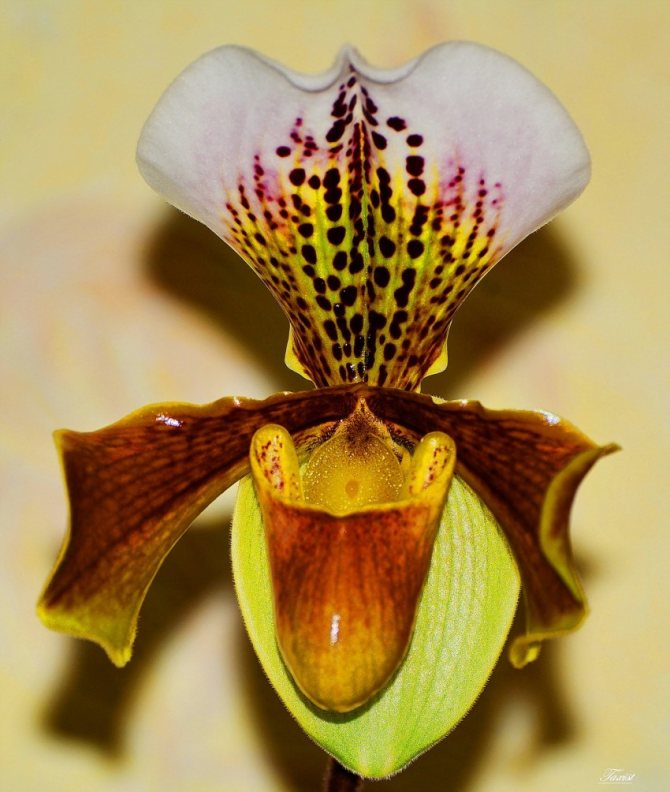



DIY paper roses - simple ways to make a paper flower and a bouquet (115 photos)- DIY paper flowers: how to easily and quickly make paper flowers (100 photos and videos)
- Do-it-yourself large flowers - detailed instructions on how to make large artificial flowers quickly and simply (70 photos)
Paphiopedilum in the wild
In nature, the lady's slipper orchid prefers moderate lighting and neutral soils with sufficient moisture... Occurs in highlands, plains, forest meadows and forest edges.
In one place the orchid "Lady's slipper" without transplants can grow for about 100 years, this is a record among flowers.
The collection of orchids is prohibited throughout Russia, the wild plant is listed in the Red Book, and it is also protected in all European states.
The type of flower culture "Lady's slipper" has perfectly adapted to winters with little snow and temperature fluctuations up to minus 30 degrees. Deforestation - natural habitats - causes great damage to orchids in nature.
Flower growers, amateurs and professionals have long appreciated papiopedilum. Many types of orchids feel great in apartments, greenhouses, conservatories... Proper competent care of a plant is one of the conditions under which it will delight its owners with flowering for many years.
Transplant and reproduction
Paphiopedilum orchid often dies after transplantation. For this reason, the plant is transplanted at intervals of 2 years. At this point, the substrate completely loses its useful properties and begins to decompose. The transplant is carried out in the spring, before flowering begins. The root system of the plant is formed in a horizontal plane, so the culture is planted in wide and low containers. Watering of the transplanted bush is started only after 5 days.
The Paphiopedilum orchid reproduces by dividing the seedling. During the division, special attention is paid to ensure that 3 sockets are formed on each part. The low number of outlets is fraught with the fact that the bush develops longer, and the flowering period is postponed for 2-3 months. The optimum temperature for transplanting divisions is 23 ° C.
Lady's slipper: a brief description
The Latin name Cupripedium calceolus means Cypride's slipper.
It is a perennial herb 15–25 centimeters high with a creeping rhizome. Refers to to the class monocotyledonous, orchid family... The lip inside with red dots, two-bladed in shape, resembling a wooden shoe, bright yellow, with a narrow mouth. Two lateral petals are linear-lacent, slightly twisted, up to 6 centimeters long. The lower and upper petals are large, the lower one is two-toothed (since two side petals have grown together). This plant of the orchid family looks spectacular when it begins to bloom - from mid-May to early June.
At the bottom of a large petal (shoe) there are juicy hairs. Flower trap for small insects. Sometimes these hairs secrete nectar, which, along with the hairs, is eaten by insects.Most
love this nectar small bees attracted by the delicate vanilla scent of the plant. Having penetrated into the cavity of the shoe, insects can hardly leave it through the narrow outlet of the anther and, inevitably, are pollinators for the flower, the pollen of which they will leave on the stigmas of other shoes.
Light mode
Paphiopedilum (orchid family), which has leathery leaves, needs more light than a plant with soft leaves. Before buds form, the flower pot is turned from time to time so that the stem and leaves are not bent.
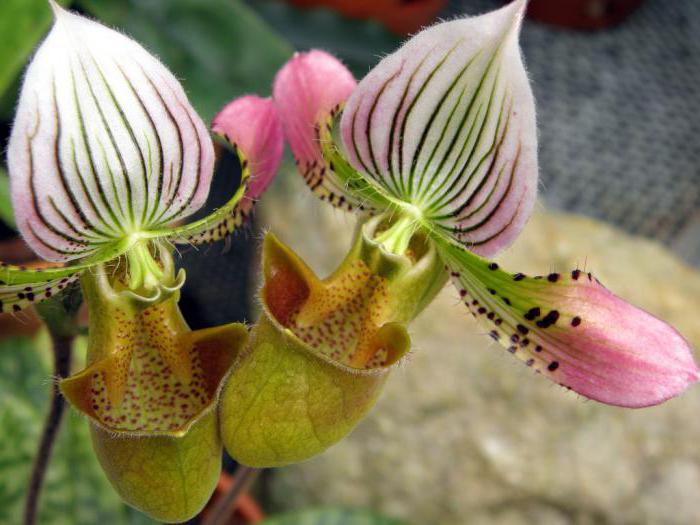

For lush flowering, orchids need 16 hours of daylight. With its lack, photosynthesis decreases. In such cases, artificial lighting comes to the rescue. Fluorescent lamps are placed 15 cm from the plant. You can increase the flow of light in the following way:
- wash windows;
- dust off the leaves;
- place the plant in a room where the walls and ceiling are light.
Habitat and species protection
This rare plant leads the life of a "hermit" and is rarely found in the wild nature of Russia, but practically throughout the entire territory of the country: the Far East, Western and Eastern Siberia, European part of Russia, Crimea, Caucasus... It inhabits mainly shady glades of warm, dry deciduous and coniferous forests, between shrubs on lime-rich soils, without direct sunlight, and sometimes comes across on the outskirts of bogs. Some species are able to withstand quite severe cold.
Like all orchids in our country, the Lady's Slipper is on the verge of extinction and is protected by the state. The plant of rare beauty is listed in the Red Book of Russia. This is due to the massive collection of flowers by people. for sale or breeding on personal plots, deforestation and destruction of forests, construction of new highways. All this ultimately leads to a reduction in the species and threatens the complete disappearance of the population. If it were not for the "capriciousness" of the flower, the Lady's slipper would certainly have received widespread decorative distribution. Today, this flower can be found only on the territory of nature reserves, botanical gardens or in remote places, where no man has set foot with barbaric intentions.
Location in the apartment
An ideal place is the window sill by the east-facing window. On the south side, the plant should be shaded from direct sunlight, especially on summer days from 10 am to 5 pm. Bright light harms the orchid: spots form on the leaves from burns, the edges of the petals become pale, the orchid stops blooming. It is undesirable to put Pafiopedilum near heating devices. Windows on cold autumn and winter days, on which there are pots of orchids, are not covered with curtains.
Legends about the shoe of the goddess Venus
According to legend, the owner of this unusual shoe is considered the Greek goddess of beauty and love, Cypriot, she is Aphrodite or Venus.
The name of the flower comes from fairy tales and legends, and the flower, with its unusual shape, reminiscent of a silk woman's shoe, appeared on earth thanks to the sweet forgetfulness and absent-mindedness of the goddess Venus.
According to one of the legends, lovers Venus (goddess of love) and Adonis (god of beauty) hid in the crown of a tree during the rain, and the golden shoe slipped off the leg of the goddess straight onto the road along which the hunter passed. Delighted with the precious find, the man stretched out his hand to the shoe, but it instantly turned into a beautiful flower.
Another legend tells us how once the goddess of beauty and love Venus wandered into the Russian forests and walked through them for a long time, admired nature, and then sat down to rest and took off her golden shoes. And leaving, just forgot them in the forest and they turned into flowers of extraordinary beauty. Seeing this miracle, the locals named the plant “Venus's shoes”.
Temperature
Paphiopedilum is not as whimsical to heat as some orchids. For its growth, a winter temperature of + 13-160C is needed, the maximum summer temperature can reach + 240C.The plant will die if the thermometer reading drops below + 80C or rises above + 320C.
Paphiopedilum, which has mottled leaves, grows well in moderate heat and dim sun, and with green foliage, it likes cool content. In inclement weather and in winter, both plants prefer low air temperatures. To control the temperature regime near the plants, a thermometer should be installed.
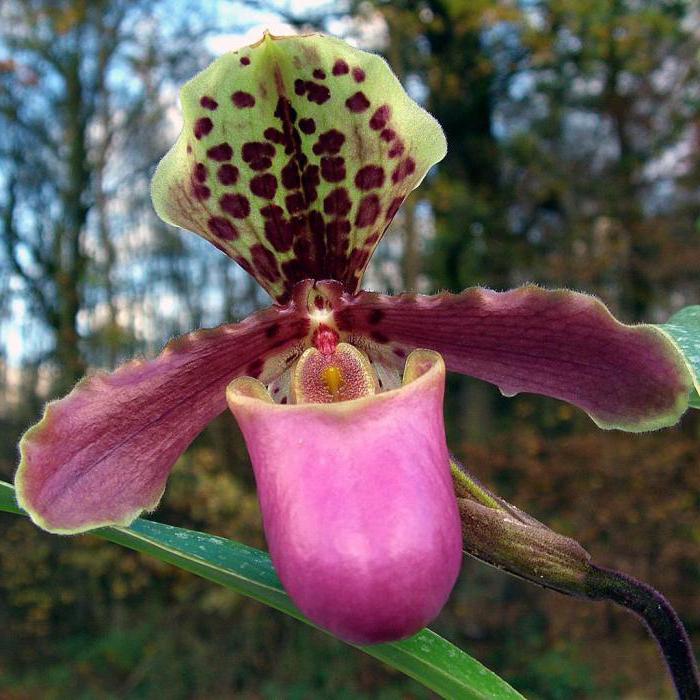

One of the conditions for the abundant flowering of Pafiopedilum is the mandatory observance of the difference between night and day temperatures by 5 degrees. You can lower the temperature by airing, watering or spraying (without getting on the flowers) plants. When performing water procedures, it is necessary to ensure that the water is boiled, filtered or rainy at room temperature. The moisture that remains in the rosettes of the leaves is removed with a napkin to protect them from decay.
The optimum humidity for this orchid variety - from 40% to 60% - can be maintained if the pot with the plant is placed on a tray with moistened pebbles.
For the successful cultivation of Pafiopedilum, fresh air is needed, so the room should be periodically ventilated without creating drafts. It is recommended to put a fan near the orchid, turning it on to a slow mode.
Venus shoes groups and categories
This orchid is rightfully recognized as the most diverse. And at the same time, all "lady's shoes" are something special, but still stand out. They differ in the conditions and care they require, in many of the nuances of growing, but the key to identifying different groups and categories lies in their flowering. It is with him that the determination of what this orchid is needed for full flowering in the house begins.
According to the peculiarities of flowering, papiopedilums are divided into three large groups - single-flowered, multi-flowered and continuously flowering varieties and species.
Paphiopedilum pretty (Paphiopedilum conco-bellatulum).
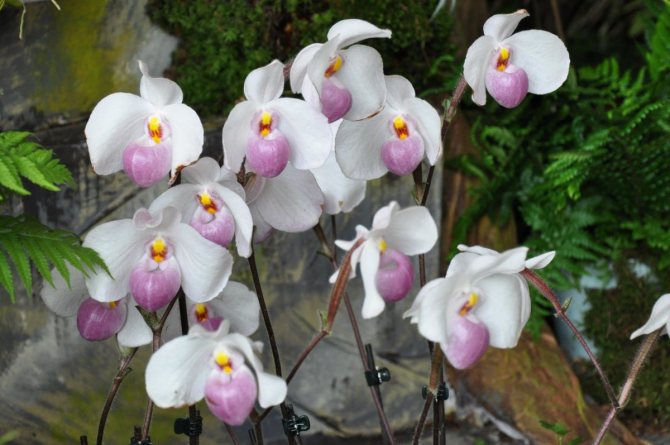

Two-flowered orchid paphiopedilum delenatii (Paphiopedilum delenatii). <>
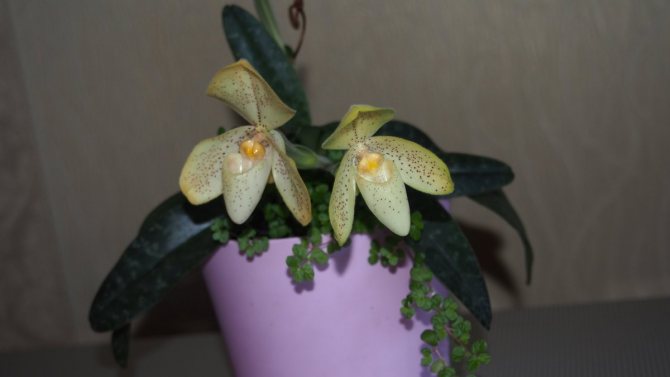

Paphiopedilum one-color (Paphiopedilum concolor).
Single-flowered pafiopedilums
This is the largest group of species and varieties, including mainly "wild" or species plants, simple and complex hybrids of "lady's shoes", from which plant breeding began.
In fact, this is a group of the oldest papiopedilums in the culture. The name of the group clearly indicates the main feature of plants - the release of a very large, but only one, very rarely - two flowers on a peduncle, which can be simply cut off after flowering. The flowering period is long enough. Flowers can last up to 3 months.
Among the species in this group stand out:
- Pafiopedilum is wonderful (Paphiopedilum insigne) - the most unpretentious of all types of Venus shoes. Its beige and light green flowers are fragrant and bloom in winter.
- Paphiopedilum is pretty (Paphiopedilum conco-bellatulum) is one of the most beautiful speckled orchids. Graceful snow-white flowers with almost black dots on all rounded petals seem to be an artificially created miracle.
- Two-flowered orchid papiopedilum Delenata (Paphiopedilum delenatii) and its numerous decorative forms with delicate pink-white colors and very large round side petals.
- The exception to the "rules" of this group - papiopedilum one color (Paphiopedilum concolor), capable of producing three delicate pastel flowers with small black specks on round petals.
- The first of the hybrids "Venus shoes" - unpretentious golden-white, wavy and watercolor Harris' pafiopedilum (Paphiopedilum harrisianum - Paphiopedilum villosum x Paphiopedilum barbata).
But still they know one-flowered "lady's shoes" by their appearance and relative unpretentiousness of American complex hybrid varieties. They produce although one flower, but up to 20 cm in diameter and with very complex speckled patterns, larger side petals of a rounded wavy shape and contrasting colors.A typical example is a light green variety with a white top petal ‘Maudiae '.
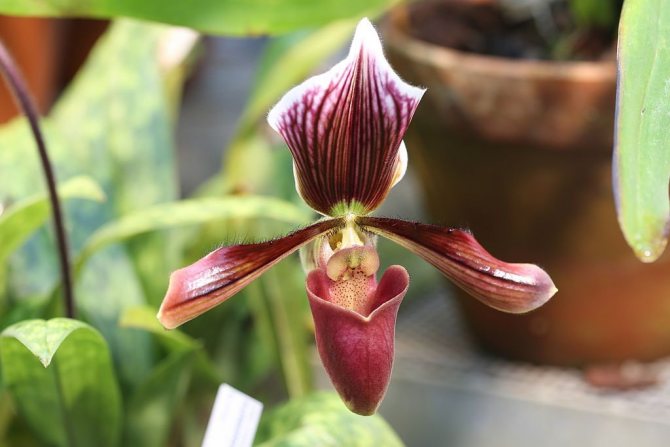

Paphiopedilum Harris (Paphiopedilum harrisianum). <>
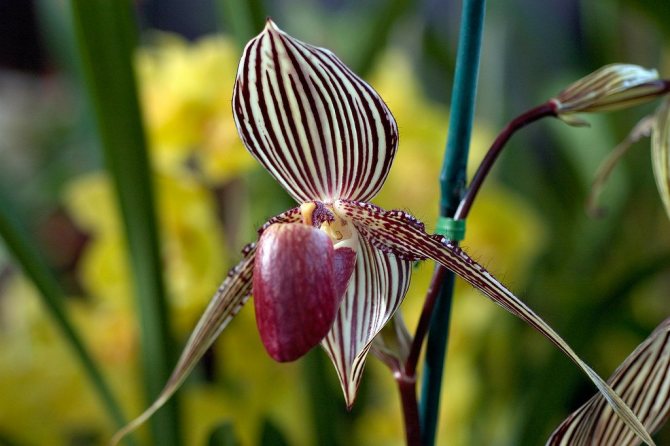

Paphiopedilum Rothschild (Paphiopedilum rothschildianum).
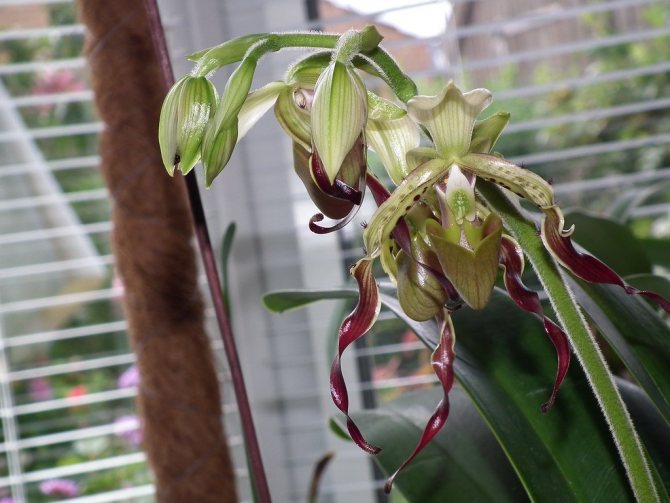

Paphiopedilum parishii (Paphiopedilum parishii). <>
Multi-flowered papiopedilums
This is a group with clusters of inflorescences, in which up to 10 flowers are collected. These orchids bloom as much as single-flowered ones - up to 3 months.
Among this group of "lady's shoes", not only varietal orchids with bright colors enjoy special love (the name often directly indicates the original type of orchid and the color shade - ‘Delenatii White’, 'Delenatii Pink', ‘Delenatii Gold’), but also some other types:
- papiopedilum "Deperle" (Paphiopedilum delenatii x Paphiopedilum primulinum) with graceful porcelain-white flowers with elongated petals;
- with thin side petals sticking out like a mustache, a red lip and a striped sail Rothschild papiopedilum (Paphiopedilum rothschildianum);
three species with long purple side petals hanging down to the leaves:
- striped yellow-white papiopedilum filipino (Paphiopedilum philippinense);
- striped beige brown purple striped Sander's papiopedilum (Paphiopedilum sanderianum),
- white-green papiopedilum parisha (Paphiopedilum parishii).
Revolving, or continuously blooming papiopedilums
This is a group of relentlessly or consistently flowering hybrid varieties, which, thanks to selection, bloom on peduncles up to 30 flowers. At the top of these papiopedilums, 1-2, occasionally 3 flowers are always dissolved.
The ability of each flower to hold out for more than a month allows the plant, even on one peduncle, to stretch the flowering period for 2 years or more. The longer it lasts, the more the peduncle lengthens and the smaller the flowers themselves are.
Without exception, all representatives of revolving papiopedilums are hybrid plants obtained mainly by crossing papiopedilum syzolic (Paphiopedilum glaucophyllum), papiopediluma Liema (Paphiopedilum liemianum), papiopedilum royal (Paphiopedilum Victoria-regina) and papiopedilum primrose (Paphiopedilum primulinum).
The most popular and "reliable" of the assortment series of revolving venereal shoes is considered group of varieties "Pinocchio" (Pinocchio) with shortened, almost linear lateral variegated petals, a swollen lip and a feather-shaped large upper petal.
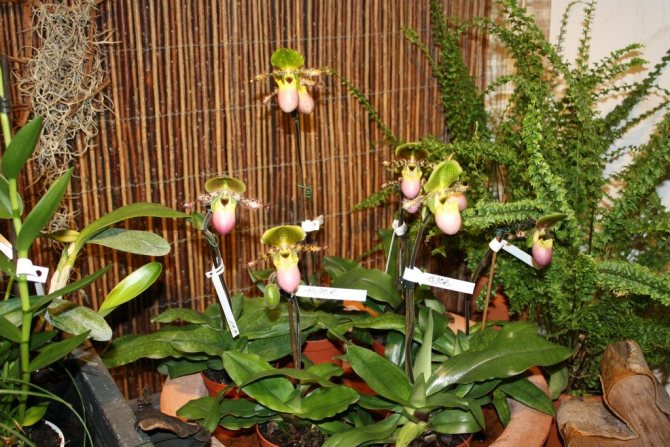

Paphiopedilum Pinocchio. <>
Reproduction methods
You can distribute this variety of orchids only by dividing the bush... When a lot of strengthened outlets have appeared, you can start dividing. If at least 3 outlets grow in the pot, then it can already be planted.
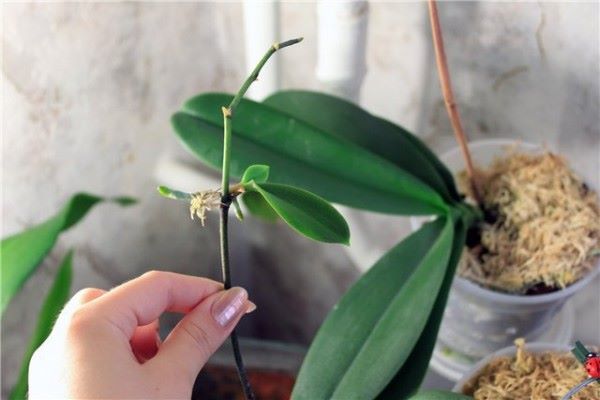

There are several ways to breed orchids.
Divided orchids are placed in the shade, continuing to spray the potting mix regularly until observed active growth of shoots... This is followed by the usual care of a perennial.
Interesting information
Interesting Lady's Slipper Facts:
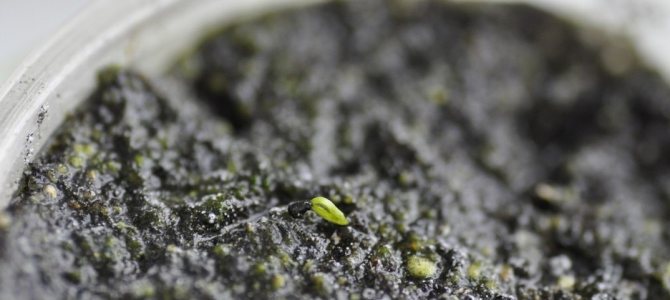

Seeds can only germinate with the help of symbiont fungi, which penetrate into the embryo and contribute to its development.- Most often it grows in forests where birch and pine trees are present at the same time.
- From the moment of germination of the seed to the appearance of the first flower, it can take up to 18 years.
- The poisonous sap, which is filled with every element of the plant, protects it from animals.
- This is a long-lived flower - its lifespan is from 50 to 100 years.
- It was listed in the Red Book of the USSR in 1984.
How to grow a lady's slipper papiopedilum at home - features of the content
Let's start with the soil: planting all the plants in a row in a store-based orchid substrate for orchids is a very rash decision. Papiopedilum is not an epiphytic phalaenopsis. Of course, he also has varieties that in nature live on trees. At the same time, some lady's shoes belong to lithophytes growing on rocks, and there are those that do grow in the soil. Therefore, it is so important to know which species you have.
Now about the lighting: it's easier with this, almost all orchids - shoes prefer diffused light. Even on the north window, the sun is enough for them. But the flowers on the southern windowsills will have to be shaded.
Have you noticed that the green leaves have acquired a crimson hue? This orchid thus tells you about the excess lighting.
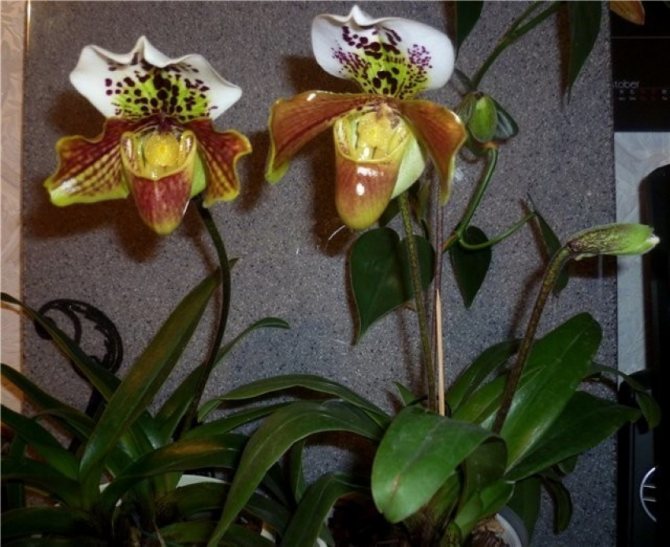

And the last thing: the temperature of the content - here, again, it all depends on the species. However, it is not necessary to know the exact name of the flower. The color of the leaves will help determine the thermophilicity. Variegated orchids like warmth, while green-leaved ones prefer cool content. In general, for all shoes, a temperature of 18 - 25 degrees is recommended. And in order for them to bloom, the plant needs to organize a dormant period in a cool room (not lower than 10 ° and not higher than 15 ° heat). But the requirement for air humidity for all pafiopedilums is the same - it must be high. That's just to reach values of at least 50% better not by spraying. It will be more expedient to just put the pot on a pallet with wet expanded clay.
Testimonials
Marina. “I bought Venerin Slipper for the first time about five years ago. The only problem I had to face was the burn of the leaves. Therefore, I strongly recommend everyone to protect their plant from direct sunlight, they are destructive for this plant variety. Paphiopedilums are plants of incredible beauty that transform any room with their presence and delight guests. They are also suitable for beginners, as it is very easy to understand the features of care. Recommend!"
Anna. “I can't imagine my home without orchids. All the windowsills are set, but I want more and more. I recently bought a Venus slipper - an incredibly beautiful flower. If you correctly provide the plant with everything it needs: moisture, light, temperature, then flowering is 100% guaranteed. The only thing that is not very encouraging is the price, and it is not always easy to find this particular variety in stores. "
Olga. “I have been growing Pafiopedilums for a long time. First of all, I recommend that beginners not be lazy and transplant a flower once a year. We all know that tap water is not the cleanest and for a year a sufficient amount of salts accumulates in the root system, which simply ruin the flower. You can stock up on a substrate in advance and make it yourself, save finances. Many varieties of orchids do not like replanting, but not a lady's slipper, they have rather sensitive roots. "
Pruning
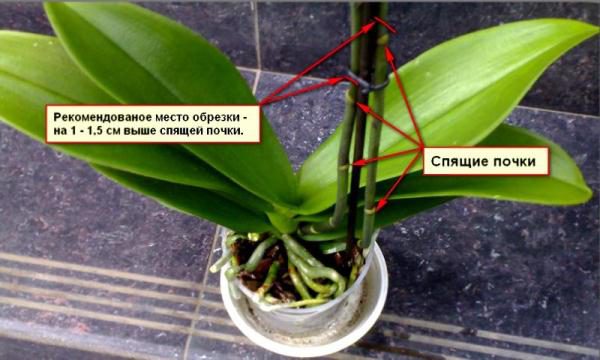

Pruning an orchid after flowering
Orchid pruning is done after flowering. The peduncle of Pafiopedilum, which gives only one flower, is cut off after it wilts, and for those representatives that have several flowers - only after the last bud has faded. The procedure and rules for circumcision are the same as that of Phalaenopsis.
A peduncle that does not have buds is cut off completely, and if any, 1-1.5 cm above the bud.
How to revive a perennial without roots?
If your papiopedilum orchid has practically no roots left, then you need to start restoring them as soon as possible. Slight drying of the soil substrate stimulate root formationThis fact has been noticed by many gardeners trying to restore orchids.
Spraying the surface of the soil and the fraction of the bark on the soil every day gives its results. To restore the orchid no need to create special conditions for her, place in a greenhouse. All these measures will give a good result in 2 months, when the young roots get stronger.
Every third watering we feed the diseased plant with fertilizer for lush orchids. For these purposes, "Rainbow" is suitable. In the sultry months water it more often.
Care features
First steps after acquisition: transplant
After purchasing, you need to carefully examine the orchid in order to identify areas damaged by disease or pests. After buying a florist performs the following manipulations with orchid:
- Place the newly acquired plant separately from other houseplant inhabitants. After that, you can safely introduce a brand new orchid to your neighbors;
- If you find bark with a white bloom in a pot of papiopedilum, then they should be thrown away immediately;
- Do not expose the perennial immediately to the sun, teach it gradually;
- If there are no drainage holes in the pot, then they can be pierced with a hot nail;
- At the beginning of adaptation, it is better not to disturb the orchid with a transplant immediately after acquisition, it is better to wait for growth;
- To maintain moisture, wipe the leaves with a moistened cotton pad.
All these recommendations will help the orchid adapt faster to a new reality.
Watering and feeding
Immediately after the acquisition, we are not in a hurry to water the orchid, we wait for an interval of 7 days, to completely dry the soil... For the Venus slipper orchid, it is important to adhere to the optimal watering regime, to prevent drying out or rotting of the roots, because the perennial simply does not tolerate this.
Watering frequency depends on:
- Selected soil;
- And the degree of air humidity.
We water the perennial with settled water with a minimum salt content, this is very critical for him. We water the plant in the morning so that all the water droplets in the sinuses dry up there.
Advice! Avoid problems with the development of various fungal ailments by simply blotting the outlet of the plant with a napkin if water gets into it.
The lady's slipper is susceptible to an excess of fertilizing, so they do it not so often - 2 times a month. At the same time, we alternate organic matter and mineral fertilizers, apply half of the dose taken.
It is necessary to feed the orchid during active growth.
You need to feed the plant only with active growththis is not required during abundant flowering. In winter, perennials need feeding once a month. To exclude increased salt formation due to fertilization, we wash the substrate every month.
Flowering stimulation methods
In order for papiopedilum to bloom, it is important to observe the temperature drops in the room. For varieties with leaves of an intense green tone, it is important for beautiful flowering observe a certain temperature regimedifferent in daytime and nighttime.
These species prefer the heat of the day in combination with the cool of the night:
- In the daytime, the air temperature should be within 24 degrees;
- At night - from 10 to 12 degrees.
Varieties that bloom variegated, require warmer air at night - from 15 to 17 degrees. At the same time, we make sure that the room is not too hot, otherwise there is a risk of losing the fragile orchid forever.
The lady's slipper will delight you with magnificent flowers. Follow the basic care behind him, and the result in the form of lovely flowers will not keep you waiting. To stimulate flowering, you need to follow the watering regime, prevent the soil from drying out, stagnating water in the outlet under the pot.
Pruning
After a long period of rest in the beautiful papiopedilum flowering period begins... A peduncle appears from the middle of a strong rosette. Depending on the shape of the perennial, there may be only one flower on it.
It will stand on a peduncle for 2-4 months. With proper care, the plant will delight the eye for 6-7 months. It is important for beginner flower growers to know that one peduncle blooms only once.
It is for this reason that in varieties with one flower, a strong peduncle is cut off, and in varieties with another beautiful flowering, the stem is left until the end of flowering.
Nuances in a period of long rest
Dormant period usually observed for fine orchid varieties with spotted leaves. This period is necessary, because it is followed by a lush flowering. Rest for Venus's slipper begins in November.
Careful care for him during this period is simple: maintaining the air temperature at 15 degrees with periodic spraying of the soil substrate with water without top dressing... After the peduncle emerges, this period ends.
Prevention of diseases and pests
The papiopedilum orchid has leaves and roots susceptible to various diseases and pests. When caring for her, often dying off of leaf plates is observed... Depending on the symptomatology, there are several objective reasons for this phenomenon:
- The leaves first take on a yellow color, then turn brown - the result of natural withering away;
- The top of the leaf becomes almost black, then the entire border of the plate darkens - this speaks from the oversaturation of the plant with top dressing or about the defeat of a dangerous fungus.
Botrytis mold causes a fragile orchid to fall off still unblown buds. This may be due to a drop in air temperature at night and high humidity.
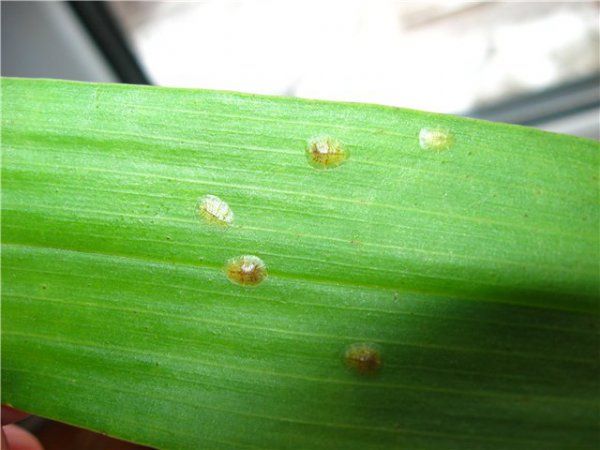

There are many pests of the Venus Slipper orchid.
Among the dangerous pests, the lush orchid Venus slipper most often attacked:
- Platypus mites;
- Mealybugs;
- And scale insects.
Conditions of detention
Watering
Florists strongly recommend that beginners protect their shoes. from direct sunlight... Otherwise, the leaves will quickly lose their appearance and burn out.
There is such an interesting folk remedy for bright and beautiful leaves - you only need to wipe them once a month with water in which sugar is dissolved or ordinary beer.
An important feature of the leaves of the Venus Slipper orchid is the ability to determine by them, what does the plant need at the moment... If the leaves are shriveled, this is the first sign that the root system is in trouble.
If the roots of Paphiopedilum have become unusable, this means that the orchid does not receive the right amount of moisture and nutrients.
IMPORTANT! Experts recommend that if you suspect that there is a problem with the root system, you should gently shake the shoe out of the substrate and carefully examine the root system.
The healthy roots of Paphiopedilum differ from other orchid varieties. First of all, by color - they have a light brown tint with small villi. The roots are a universal part of the orchid; it can also be used to determine the phase in which the pet is now located.
The main reasons for the death of roots are - waterlogging or vice versa - lack of moisture. Watering is recommended with settled water at room temperature.
If the root system has come to an end, the first step is to transplant the plant into a fresh substrate. When transplanting, first of all, you should get rid of the dead roots.
The soil
Ideal for Pafiopedilum is such a substrate:
- The main part is made up of finely chopped pine bark;
- Dried pieces of moss (preferably sphagnum);
- Fine charcoal;
- Fern roots (optional).
The best soil for orchids is pine bark.
These components are moisture-consuming, which is great for the root system of this orchid. The main advantage of such a substrate is that the elements included in its composition can be obtained with your own hands in the nearest pine forest. The best time to do this is in the spring.
The bark is best collected from the one that lies around the tree. She must be not very thin... Sphagnum moss can be found in swampy areas. This moss does an excellent job of retaining moisture.
The simplest task is find charcoal... To do this, just break the charred log and voila - another ingredient for the substrate is ready. As for the fern roots, it is used only in dried form and is harvested in summer. It is recommended to take care of the blanks in advance.
Temperature
All Pafiopedilums are divided into 2 main categories: heat-loving and cold-loving. Understand what kind of tropical beauty lives on your windowsill, simple enough:
- Venus shoes, which boast variegated leaves, prefer warmth;
- While green oblong leaves are a sign that the orchid prefers coolness.
Sometimes you can find hybrids, which are in dire need of lowered temperatures, to the so-called cold wintering. Only a decrease in the night temperature to 10 degrees can stimulate orchid flowering.For typical representatives, the optimal temperature is 18-25 degrees.
IMPORTANT! An increase in temperature to 35 degrees can lead the plant to death.
Lighting
The most important rule when organizing lighting for Pafiopedilums is to minimize risks. direct sunlight... It is best to find a place in the house where there is shadow.
Often among ardent fans of orchids, all the seats on the windowsills are occupied. If, for some reason, the plants do not get natural light, experienced florists recommend use artificial lighting, including lamps.
It is recommended to turn on the artificial light for at least 10 hours.
Fertilizer
Fertilizing the plant is recommended during the period of active growth... It is imperative to alternate organic fertilizers with mineral fertilizers.
Fertilizers should be treated carefully and not overdo it, because the Lady's Slipper is enough reacts negatively to an excess of feedingleading to death. In order to prevent such an outcome of events, the orchid should be transplanted about once a year.
Types of papiopedilum
In the genus Papiopedilum, there are up to 80 species, but their number is constantly changing. The number of natural and artificial hybrids is also changeable, more than a thousand of them have been created. The most famous types in indoor and greenhouse floriculture:
Pretty, or bellatulum - originally from Burma. Snow-white flowers in crimson dots with a circumference of about 8-10 cm, appear in April. Leaves are spotty.
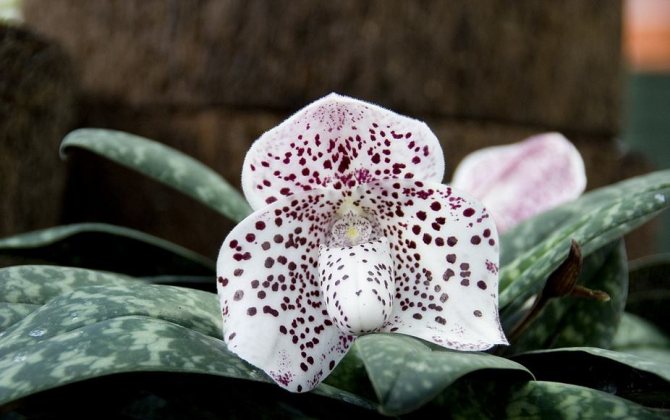

Paphiopedilum Bellatulum (Pretty)
Apricot is a very late discovered species, in 1982, with spectacular sunny yellow flowers with orange throats and mottled foliage.
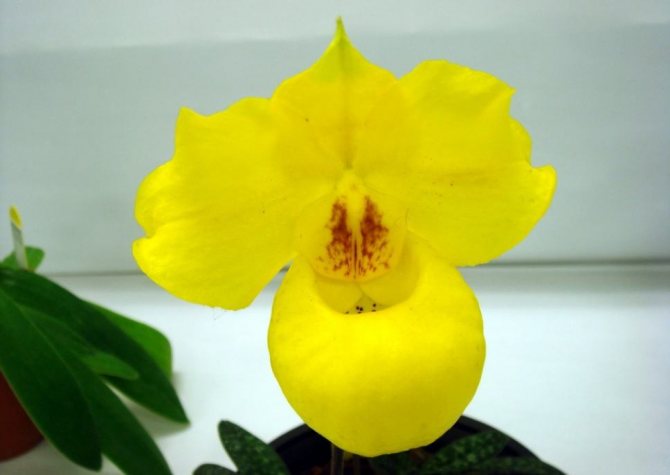

Paphiopedilum armeniacum (Apricot)
Adorable, or beautiful - originally from the Himalayas. Blooms at the end of winter in large single flowers about 15 cm in diameter. The lip is orange with greenish veins, the petals are in the same tones, dotted with distinct longitudinal stripes.
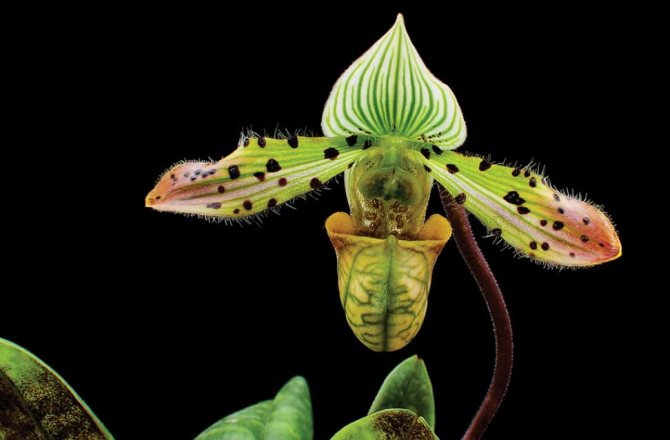

Paphiopedilum venustum (Adorable)
Snow-white - has a pleasant aroma. Leaves in marble patterns. The flowers are pure white, shining, with a circumference of no more than 8 cm, bloom in summer. It is extremely gentle, thermophilic and requires much less fertilization than other species.
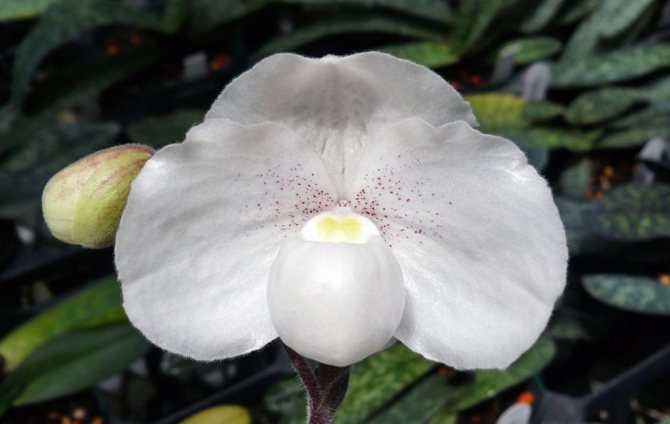

Paphiopedilum niveum (Snow White)
Lawrence is the birthplace of the island of Borneo. Luxurious view with a gorgeous flower 9-13 cm in circumference. The sail is white with longitudinal purple veins, the lip is cherry red. Blooms in spring.
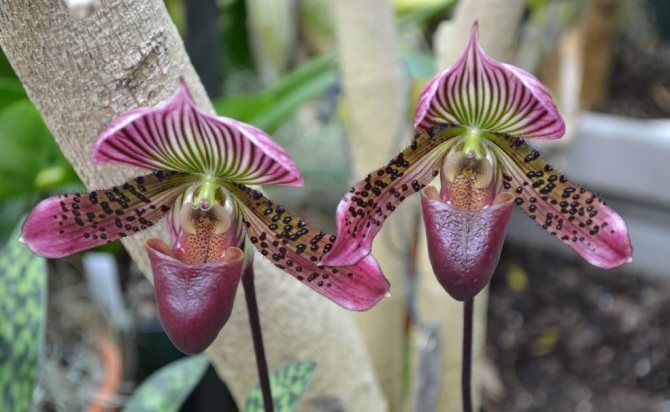

Paphiopedilum lawrenceanum (Lawrence)
Rough-haired - Indian species, blooms continuously from autumn to early or mid-spring. The upper petal is claret-brown, the edge is greenish-white, the lateral ones are of an ocher-chocolate hue, the lip is pale brown with reddish stains.
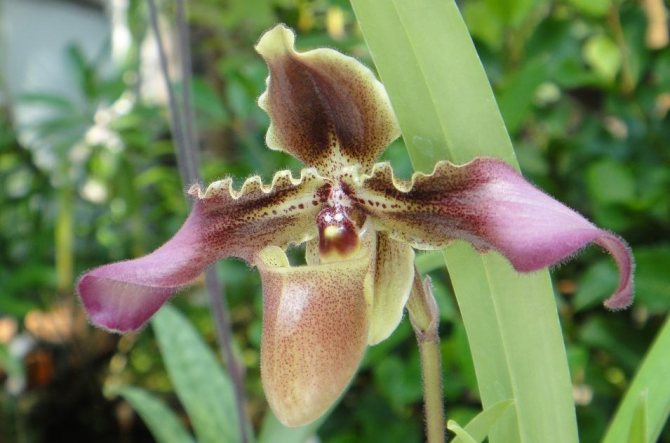

Paphiopedilum hirsutissimum (Rough-haired)
Monochrome, or concolor, is common in southwestern China, southeastern Thailand, Burma, Cambodia and Laos. The flower is up to 5.5-7 cm in diameter, cream or yellowish, less often white or ecru, covered with small purple peas.
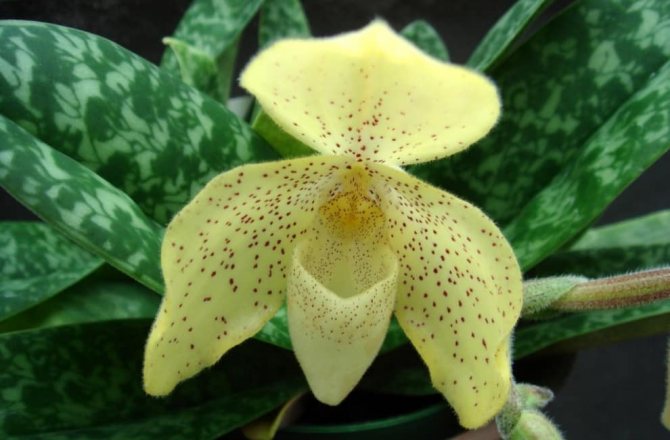

Paphiopedilum concolor (Monochrome)
Wonderful - Himalayan species, blooms from September to February with greenish fragrant flowers.
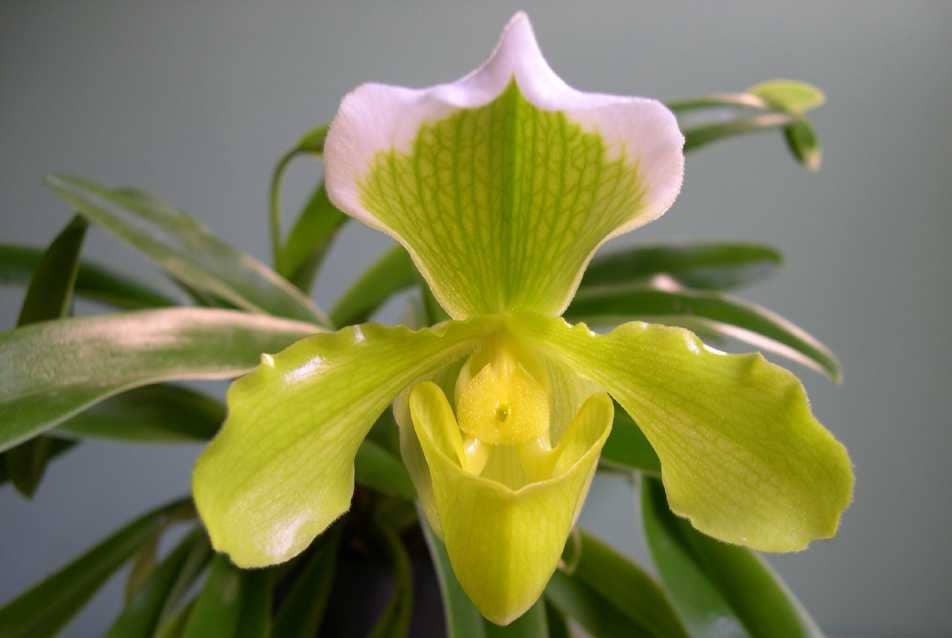

paphiopedilum insigne (Wonderful)
The bearded one is the parent of the first artificial hybrid; in culture it began to grow earlier than other natural species. The foliage has an expressive marble pattern, the flowers are painted in red-purple tones: a sail in burgundy stripes on a white background, a lip and side petals of a dark scarlet shade. Blooms in spring.
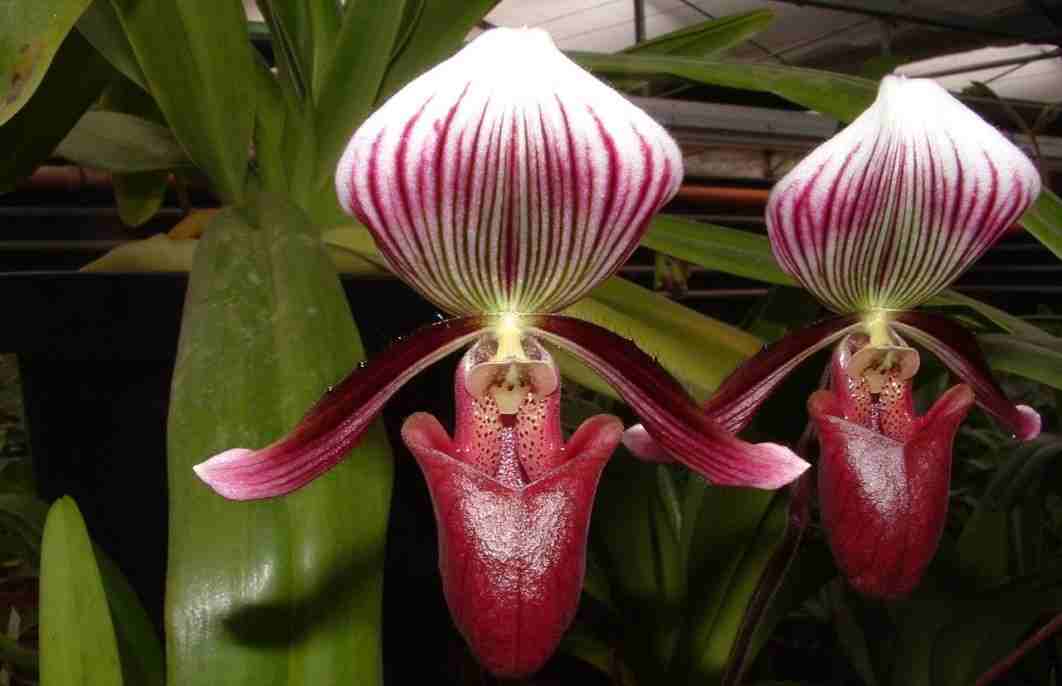

Paphiopedilum barbatum (Bearded)
Appleton is a large spring-blooming orchid with spotted leaves and a greenish-lilac flower up to 10 cm in circumference, native to Southeast Asia.


Paphiopedilum appletonianum (Appleton)
Optimal growing conditions
Suitable content temperature
In the group of this variety, there are warm and cold-loving varieties. They can recognize by tone flower:
- Bright inflorescences characterize thermophilic varieties;
- Leaves of an elongated shape of an intense green color - a cold-loving species.
Before flowering lovely papiopedilum, it is necessary recreate a dormant period with an optimal air temperature of 10-15 degrees. If the accepted temperature fluctuations are not created, then flowering should not be expected.
This orchid is very susceptible to fluctuations... For optimal growth and vegetation, temperature fluctuations can range from 18 to 25 degrees:
- In winter, the column should not fall below 10 degrees;
- In summer, do not go up to 33.
Comfortable level of air humidity
Paphiopedilum loves moist air without leaf spraying. Optimum humidity - from 45 to 70%. If drops of water fall on fragile leaves, then ugly spots will form on them.
We maintain a high level of humidity with expanded clay placed in a pallet. At the same time, make sure that the bottom of the flower did not touch the waterpoured into a pallet. For this purpose, a pot of growing papiopedilum is placed on an inverted saucer of a pallet.
Advice! It is possible to increase the room air humidity with a modern nebulizer.
Room illumination degree
This kind of orchid love diffused light, they cannot stand the direct rays of the sun. On the south window, the delicate slipper is slightly shaded. Keeping orchids outside the window is also not advised, since then they will require 12 hours of lighting.
The current lighting conditions change gradually so that the perennial has time to adapt to the new environment. Move them from shade to sun every day for 3 weeks.
Attention! If the leaves of papiopedilum become reddish, then it indicates a strong degree of illumination, the plant requires shading.
Accommodation at home
The optimal place for placing an orchid is home windowsills:
- Northeastern;
- Eastern;
- And western windows.
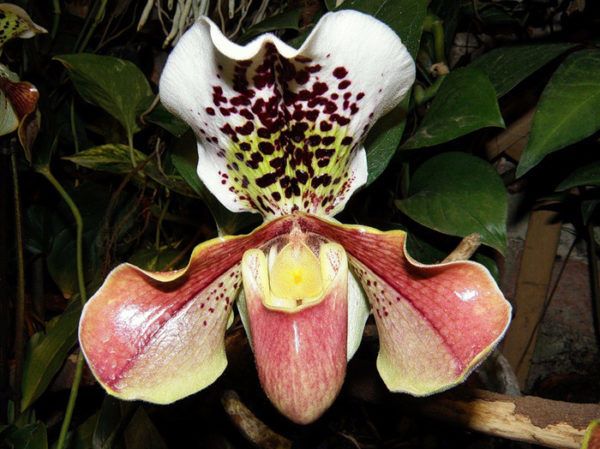

The Venus Slipper Orchid does not need to be placed on the south window.
Some subspecies also thrive in the northern part of the house. A room containing a perennial plant requires frequent ventilation, in the summer it is placed in the garden.
To start flowering
To provide an orchid with lush flowering, you need to create 16-hour daylight hours for it. You can do it using a fluorescent lamp... With a lack of light, it reduces the level of photosynthesis, artificial lighting will help speed up the onset of flowering.
To increase the flow of light, washed window frames, wipe dust from the leaves, place the perennial in a room with light walls and the same ceiling.
Bloom
Competent care involves the annual flowering of the Venus Slipper. Most often, this period occurs in the autumn-winter time. It is very simple to determine that the flower is in full readiness and will soon begin to delight with inflorescences - a stop list appears from the point of growth.
To size it is smaller than standard pieces of paper and usually does not grow further. This means that the orchid will soon begin to bloom actively.
This moment is inevitable if all recommendations were taken into account when growing an orchid and favorable conditions were provided throughout the year. When the stop list is compacted, a bud emerges from it.
IMPORTANT! During the flowering period, it is forbidden to disturb the orchid, especially to rearrange it to another place. After all, if the plant begins to bloom, then the conditions for this are quite favorable and any changes can only harm.
Usually the Lady's Slipper does not hibernate, but after flowering it still needs a short rest... To do this, lower the temperature slightly (15-18 degrees) and reduce the intake of moisture.
As soon as the plant begins to delight with a new bud, the rest period is over and now it should be returned previous containment conditions, that is, raise the temperature, resume watering and feeding.
Popular species and varieties
Each type of orchid differs from each other in color shades, the length of the leaf plate, and the size of the bush. Many experts have come to the same opinion that no flower is inferior in beauty to the Venus shoe (Pafiopedilum). All plants are classified by type of bud and flowering time. The most popular varieties used by flower growers:
- Spotted (speckled)... The height of the plant is 30 cm. Like other species, it has thin creeping roots. The stem looks glandular, covered with fine hairs. The length of the leaf plate is 10 cm, the width is 5 cm. It forms one bud on the peduncle. The color is spotted with a bright purple hue, the upper petal is light. The blooming period of the spotted shoe falls on May and lasts 30 days. This flower is toxic.
- Real slipper... The root system is branching, shortened, with many thick roots. The length of the shoots is 0.4-0.5 m in height. The shape of the leaves is elliptical. A distinctive feature of the shoe is large buds with a bright yellow lip and brown-red sepals. There are white flowers with a bright red color, as well as greenish, chestnut. The beginning of flowering falls on the end of May and lasts until the end of the first decade of June. Seed formation occurs in late summer (August). The degeneration of a real shoe occurred due to its frequent use in floristry.
- Acaulescent... It is very difficult to grow this kind of house. All specimens with a damaged rhizome die. The lifespan of the remaining transplanted flowers does not exceed 5 years. This is due to the fragility of the roots or the wrong substrate. The root system of the plant is compact, the ground stem is bare. The leaves are thickened, oblong, deep green, extending directly from the roots. The sepals can be green or dark red. The lip is small, up to 5 cm long. The transverse fold creates a bifurcation effect. A unique fragrant aroma distinguishes the stemless slipper from other varieties.
- Small-flowered variety... You can recognize this type of shoe by its small flowers, the size of which does not exceed 10 cm. Lip color is pale yellow or bright. Sometimes there are specimens of white, mottled red. The shade of the sepals is dark red or green. Peduncle length 25 cm. The root system is short, fibrous. 3 pubescent leaves depart from the roots. The shape of the leaves is oval in length - 15 cm. It grows in harsh conditions on calcareous soils. The plant forms larger flower stalks when transplanted into mineral-rich soil in a mild climate.
- Large-flowered... Plant height - 45 cm. Leaves length 8-16 cm, width - up to 8 cm, oval shape, covered with fine hairs. The diameter of the flowers is large, up to 10 cm, due to which the name large-flowered appeared. The range of colors can be different from pure white to pink-burgundy. There are specimens with purple spotted sepals. Lip length 7 cm, swollen shape, edges curled inward. This variety belongs to rare species, grows on moist soil, which includes humus. The leaves of the plant contain a large amount of ascorbic, oxalic acid and other useful microelements. Due to this composition, the plant is used in medicine.
- California... This variety of slipper is native to California and is the most prominent representative of Orchids. A distinctive feature is the compact size of the flowers, a small creamy lip. One peduncle is capable of forming up to 12 buds. The height of the plant reaches 120 cm, the leaves are arranged alternately along the entire stem in an amount of up to 10 pieces. The plant grows well in humid conditions, but not in wetlands. The flower can be found in coastal areas, on the banks of water bodies.
- Ramhead... Perennial height 30 cm.The gnarled root system produces about 12 slender shoots. The leaves are fragile, oval in shape, the number is from 3 to 5 pieces. The arrangement is spiral. Flowers are small purple-white or white-red shades. They grow singly, on each peduncle. In rare cases, 2 flowers can form. Blooms in May or June for no more than 7 days. Grows in warm, humid places with neutral or slightly acidic soil. Does not tolerate dark and completely open areas.
- Knotty... A low-growing plant up to 40 cm in size. The location of the roots is superficial. The stem is pubescent. The buds of greenish shades rise above the paired leaves located at the very roots. The shape of the leaves is pointed. Large single inflorescences exude a pleasant smell. The color of the buds is bright. The lip is spherical, sometimes with a longitudinal fold. The sepals are yellow-green, with purple blotches. The plant is found in the forests of western America, in areas with a moderately cold climate.
- Queen's slipper... The height of the bush is 0.9 m. Small root system. The stems are powerful, covered with fluffy hairs. The arrangement of the leaves is alternate in the amount of 3 to 9 pieces. The length of the sheet plate is 0.3 m, the width is 0.1 m, the shape is elliptical. Color - green, bright shades. Flower diameter 0.8 m, white or pinkish color. The lip is voluminous, white, covered with purple or crimson spots. This frost-resistant variety is able to withstand temperatures down to -40 ° C. Does not grow in areas with hot climates.
- Mountain... In the wild, it grows on mountain slopes, in deciduous forest zones, thickets of bushes, and tolerates any natural disasters. Despite good stability at home, it does not live for more than 2 years. The stem of the plant is erect, 0.25-0.72 m long. The shape of the leaves is ovoid. If the flower grows in a sunny area, then its leaves are ascending, and if in a shady area, they are open. The number of flowers varies from 1 to 3 pieces. The lip is white, the sepals are green or red.
Interesting! The lady's slipper is a long-lived flower. Its life span is 50-100 years.
Diseases, pests and problems in the cultivation of papiopedilum
This orchid is extremely sensitive to cold and improper care. Paphiopedilums shed their buds, they can stop flowering if too much moisture and too low temperatures.
"Lady's shoes" often signal problems with the substrate due to changes in the leaves. If the leaves turn brown without yellowing, blackness spreads from the top in a kind of border, the plant signals an excessive salting of the substrate or the defeat of fungal diseases.
Of the diseases on the plant, botrytis is often found, causing damage to flowers and their fall, as well as all types of rot and fungal root infections. It is worth fighting any diseases immediately with an emergency transplant and fungicides, in case of severe damage - removing the damaged areas of the roots and drastically cutting off the plants.
Occasionally, these orchids become infected with scale insects, mealybugs, spider mites.
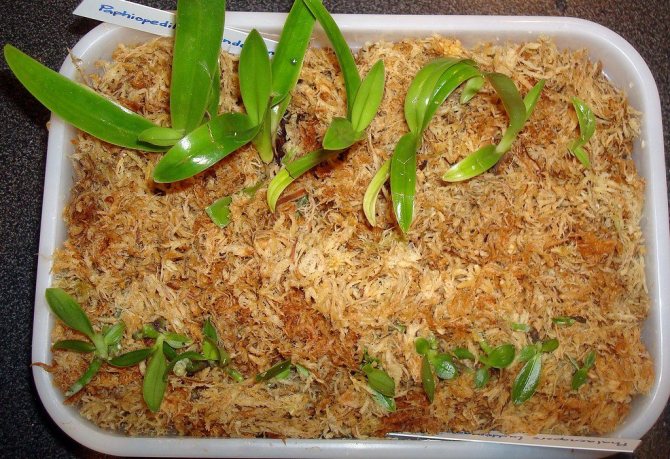

Adult shrubs of "lady's shoes" are divided when they grow too large or there is a desire to increase the collection.
The main problems of growing
If pafiopedilum is grown from one outlet, then it is incredibly difficult for it to increase the leaf mass. Rotten roots can be from:
- Incorrect watering regime;
- Overfeeding;
- Poor quality soil composition.
You should not rush to remove the faded outlet, because the life and development of new outlets depends on it. Pafiopedilum acquires its own roots only in the second year of life.
With a strong deepening of the neck, it begins contact with damp substrate, which negatively affects the development of the flower.
You need to be extremely careful with orchid leaf plates, because the direct rays of the sun can burn them, so brown spots can form on them. To protect the plant from spider mites, we wipe its leaves once a week. damp cloth.
The lack of flowering may also indicate non-compliance with the irrigation regime and temperature drop. The dying off of faded buds is a normal renewal process, you should not be afraid of it.
Orchids with sympodial growth
Sympoid form assumes horizontal growth.
In the next season, they give a new, lateral growth. Pseudobulbs live for about 2-3 years, after which they turn yellow and die off. When the pseudobulb reaches at its peak of maturity, its upper bud falls off or becomes an inflorescence.
The growth of the false bulb ends together with the end of peduncle formation, a new sprout forms at its base and the next annual development cycle begins.
It is quite rare that such a sympodial type of orchid is found in which the kidney shoots the arrowlocated at the base of the shoot or at the top of the flower. The leaves of these orchids are rather thin and narrow.
This is exactly the type during flowering stimulation needs to lower temperatures. It is also recommended to reduce watering, in the next 8 weeks the orchid will feed on the moisture that the pseudobulbs have stored.
In order to stimulate the flowering of the Venus Slipper orchid, you need to lower the temperature in the room.
You can meet this type of orchid in nature in areas where heavy rains prevail, which periodically give way to dryness. Such climatic conditions are typical for the tropics.
Of course, it is quite difficult to provide such periods at home, therefore, by trial and error rather unpretentious Venus shoes were brought out.
IMPORTANT! Almost all Paphiopedilums sold in flower shops are hybrids that require moderate temperatures and can easily do without a serious dormant period. For their cultivation, there are enough natural temperature drops that occur when the seasons change.
Wildlife
On the territory of Russia, this perennial flower is less common than in America, the mountains of China, Mongolia and Japan. The places where the lady's slipper grows are distinguished by rather moist soil and a large amount of lime. The plant prefers mixed forests, ravines and steep river banks.
Wild flowers are found in clusters in shaded areas with a lot of moss. Some countries have very similar closely related species. Other plant names are widely known:
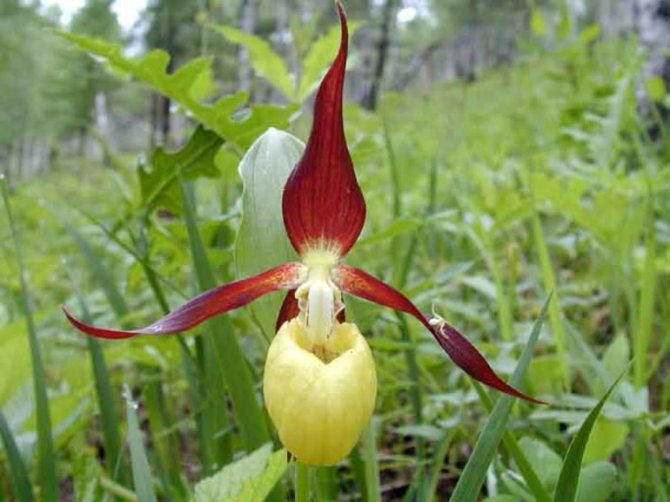

- Adam's head;
- lime slipper;
- cuckoo boots;
- cockerels.
Interesting information: a lady's slipper, planted in open ground, begins to bloom only after 15-20 years.
To protect against wild animals, the flower has a poisonous sap with a pungent odor, which is absolutely safe for humans.
Mr. Dachnik informs: pafiopedilum - medicinal properties, use and contraindications
In the industry of unconventional treatment, the lady's slipper is widely used to get rid of a variety of diseases. Most often, drugs with the addition of papiopedilum are used to get rid of insomnia and migraines. In addition, decoctions from this flower can heal epileptic seizures and improve appetite.


Means prepared on the basis of orchids guarantee the following effect:
- laxative;
- exciting;
- pain reliever;
- sedative.
Decoctions from a flower are used for uterine bleeding, diseases of the heart and blood vessels, hepatitis. Special attention should be paid to the funds from the large-flowered type of shoe:
- Infusion for the treatment of gynecological diseases. One fresh plant is poured with 300 ml of boiling water and infused for several hours. The resulting product is used within a day.It is allowed to drink it after labor, since the medicine has a blood-purifying effect.
- Depressant. A teaspoon of the dried plant is poured into a thermos and poured into a glass of boiling water. The product is infused, filtered, after which it is ready for use. Recommended for use in the presence of neurological diseases.
- Diuretic infusion. A teaspoon of the crushed plant is added to 200 ml of boiling water. The tool is infused, filtered, and then used in the amount of 1 tbsp. spoons after meals.
- Broth for colds. 5 g of dried flowers are poured with 200 ml of boiling water. The product is cooked for 5-10 minutes on low heat, cooled and filtered. It is taken in a volume of 5 ml before meals.
But, despite such a number of positive properties in the lady's shoe, preparations with the addition of this plant are strictly prohibited to use during the period of gestation and lactation. In addition, it should be remembered that there are many alkaloids in the composition of papiopedilum, which have a toxic effect and, if the dosages are not followed, can cause serious poisoning.

